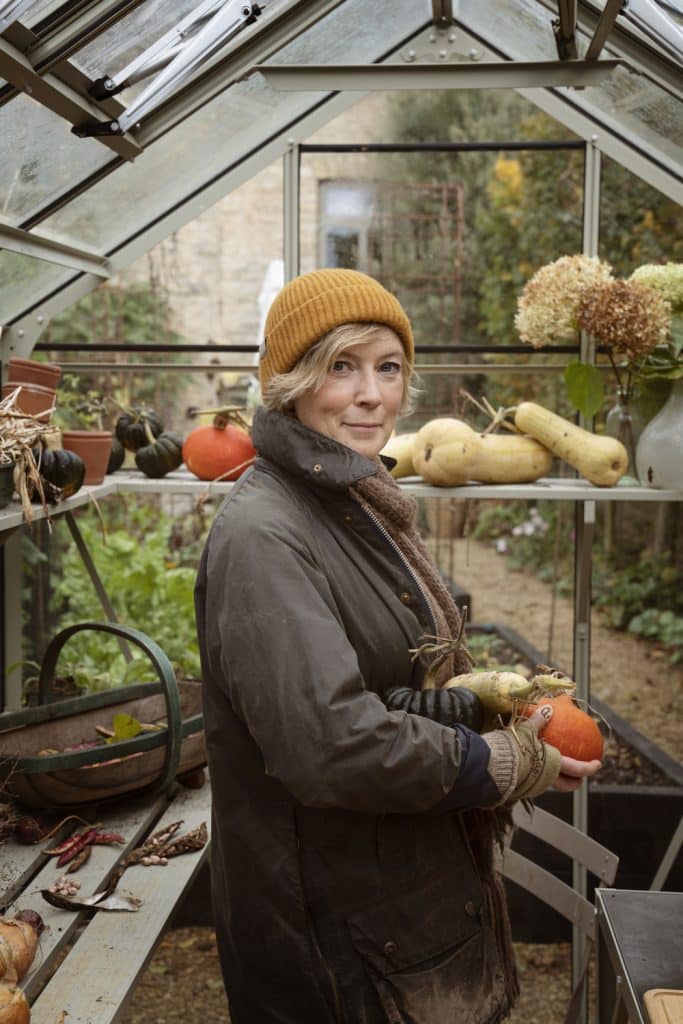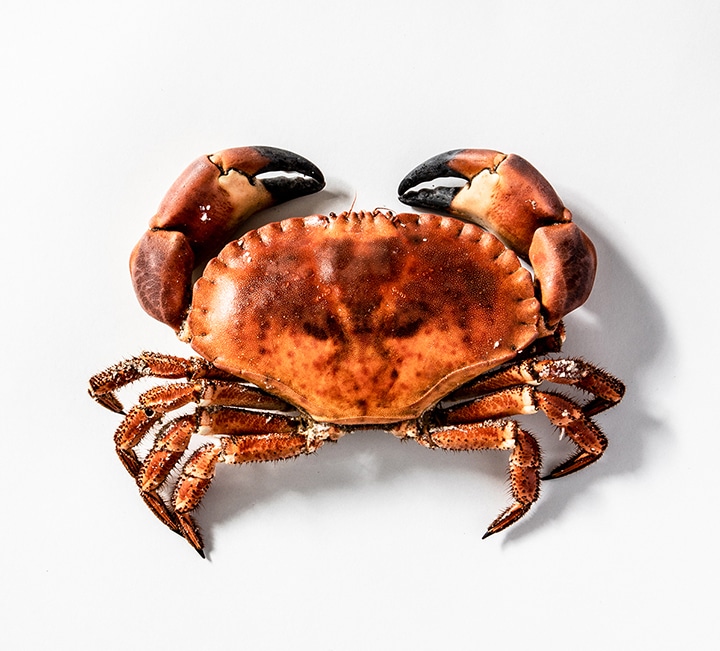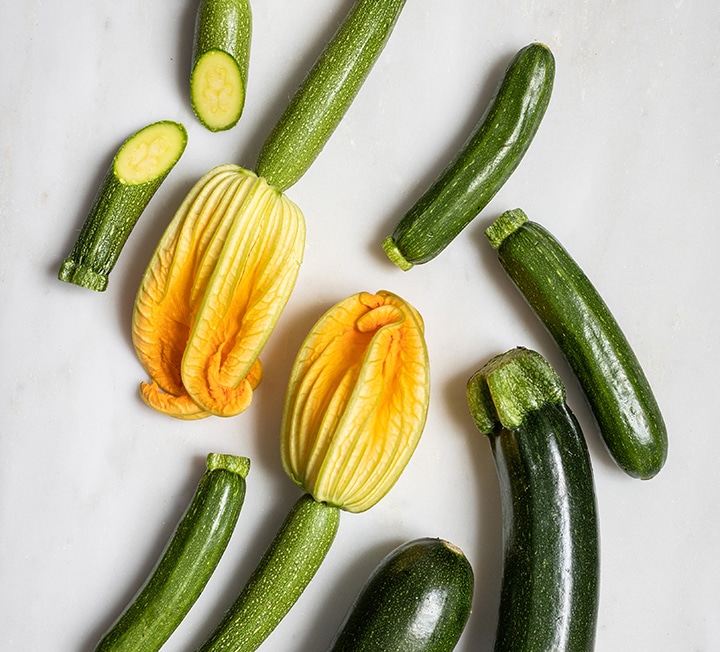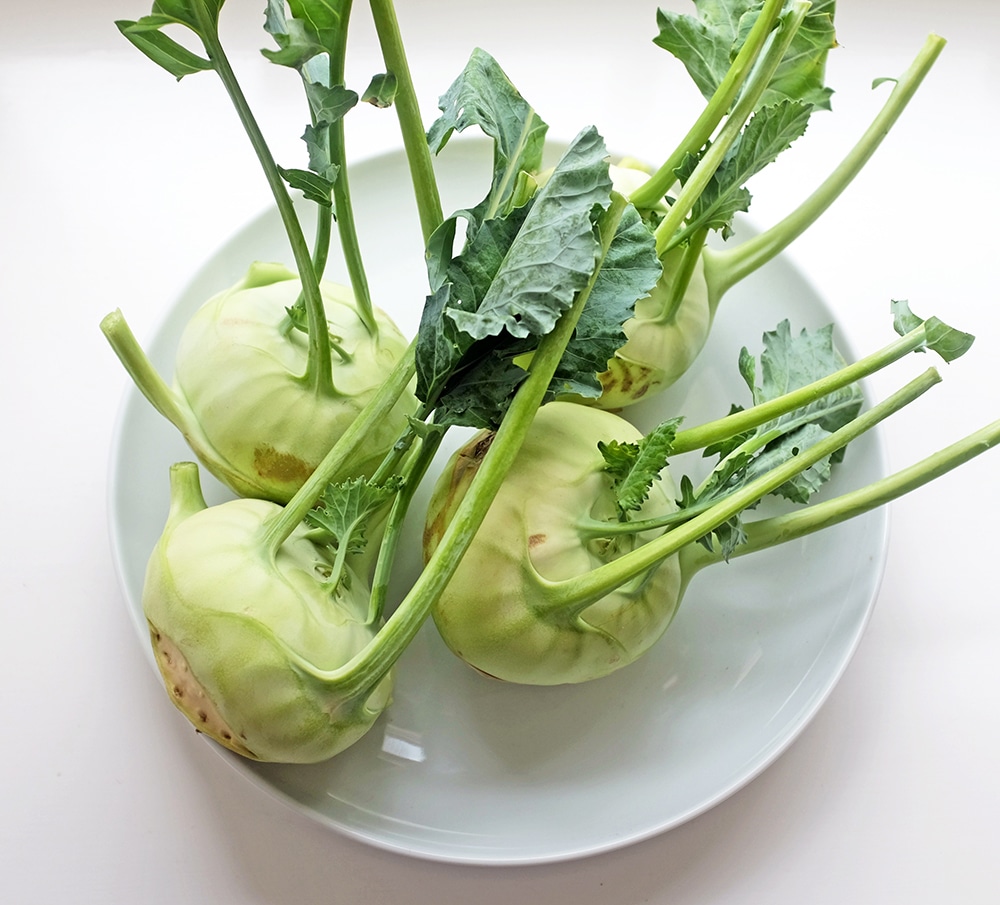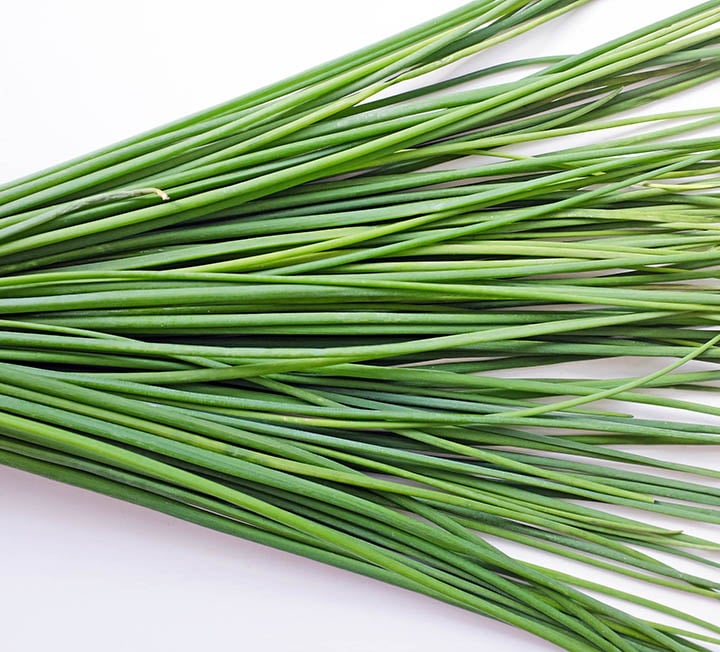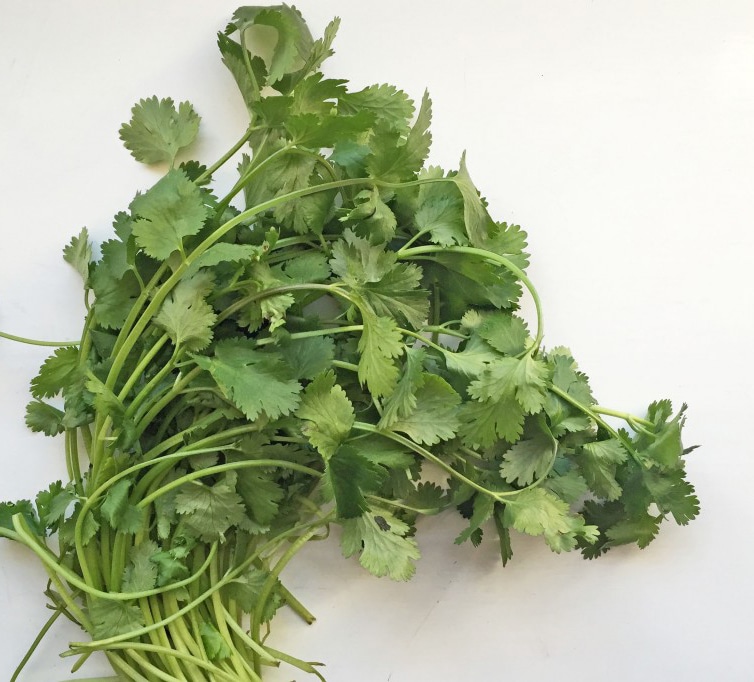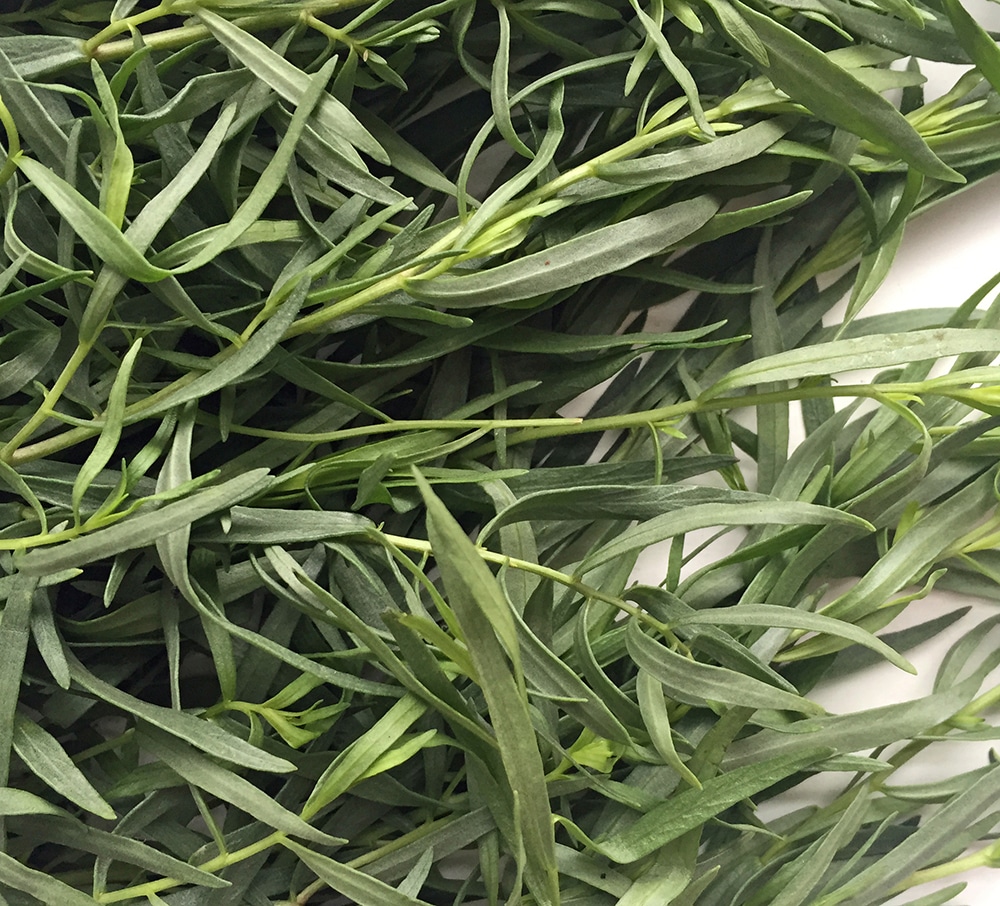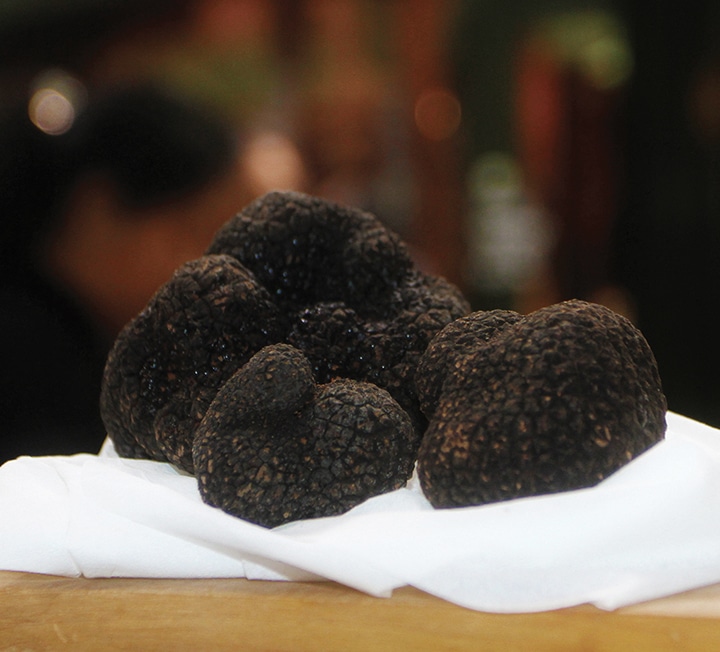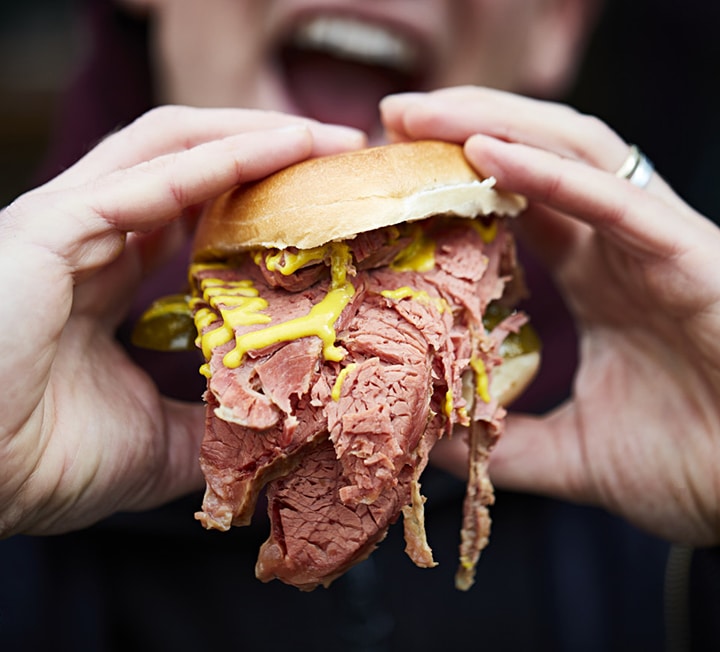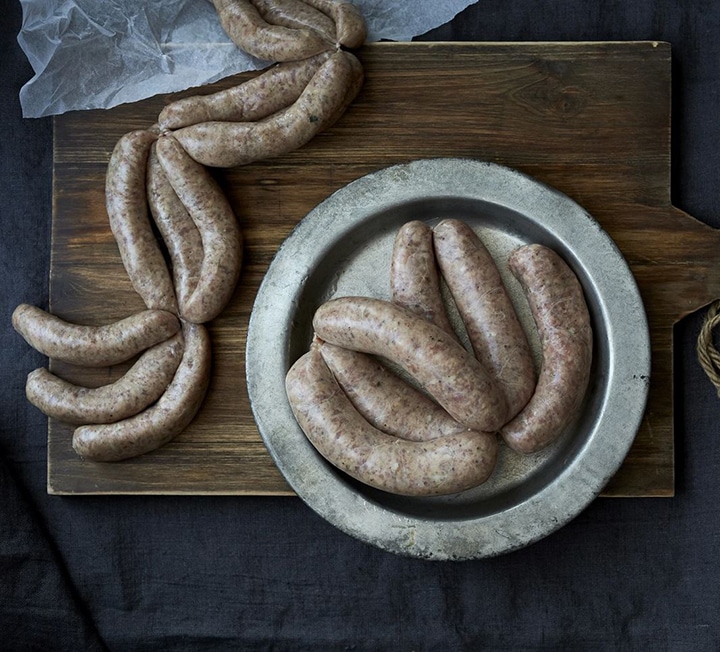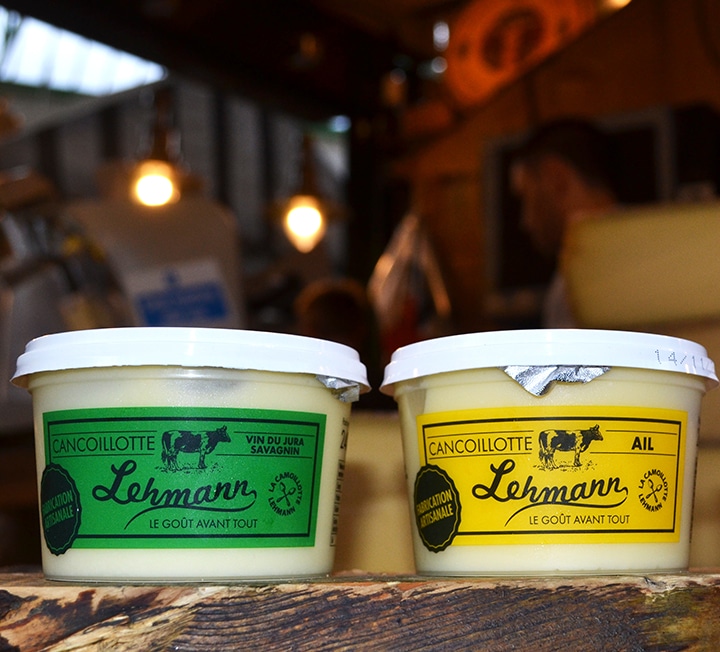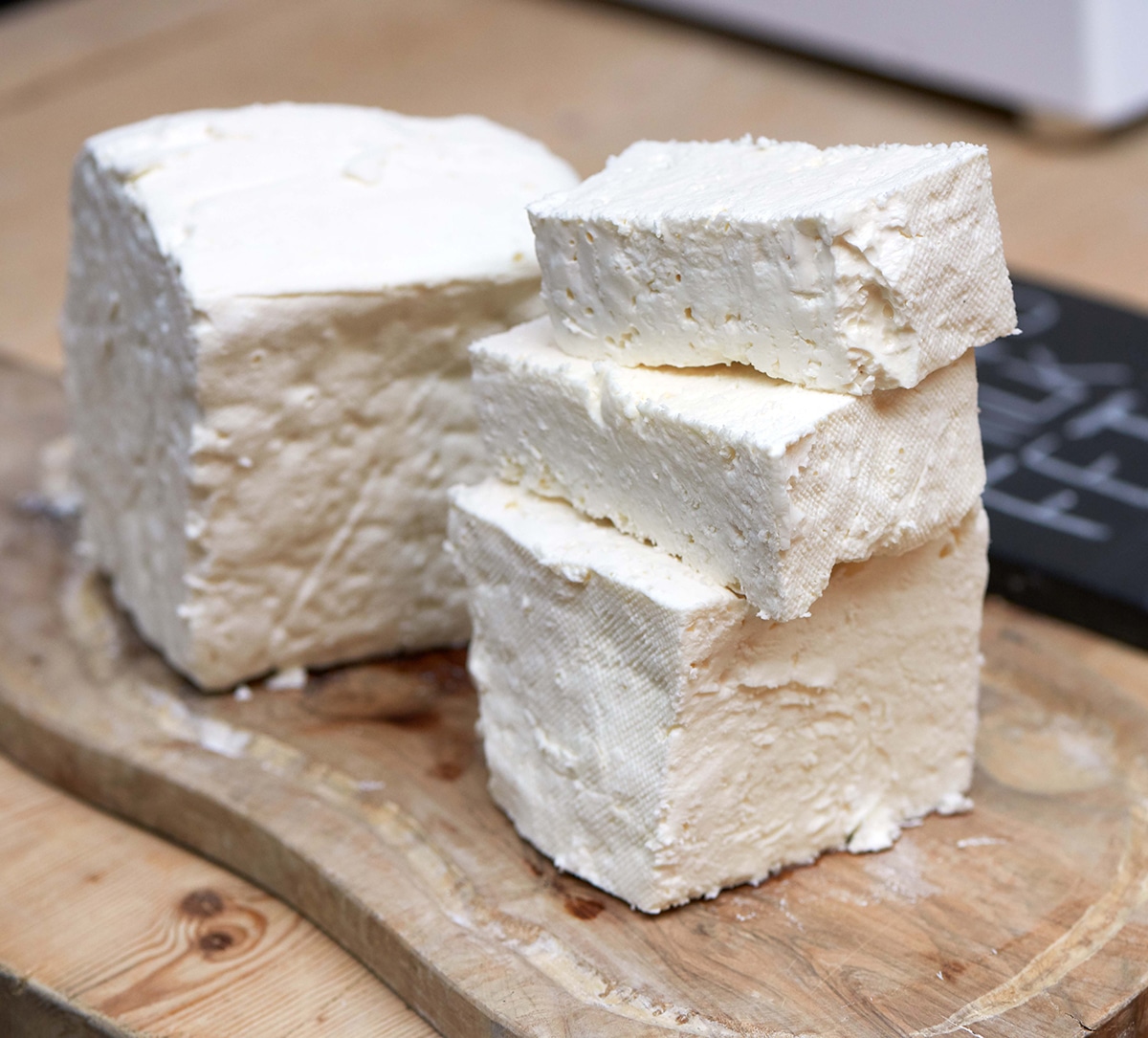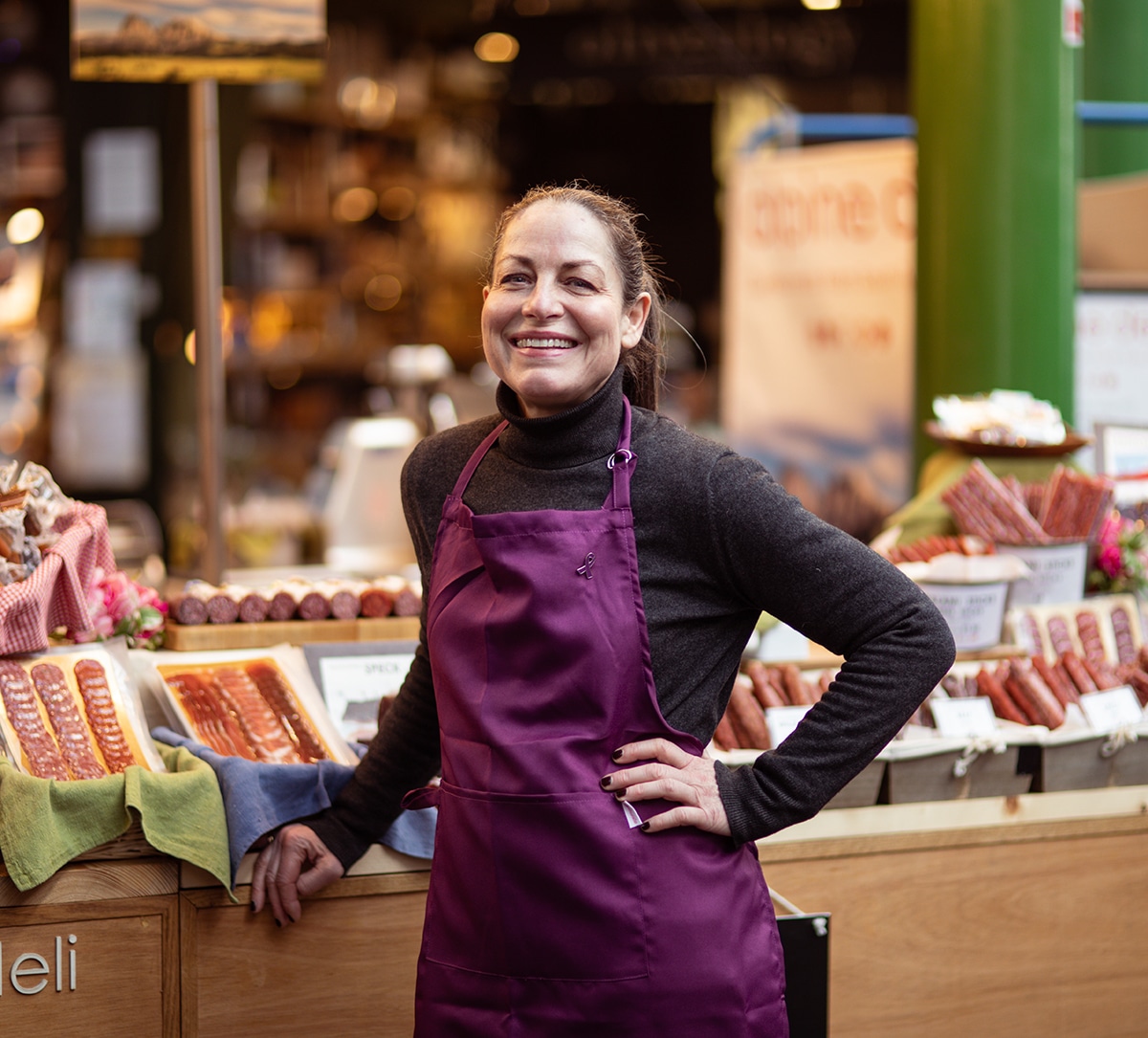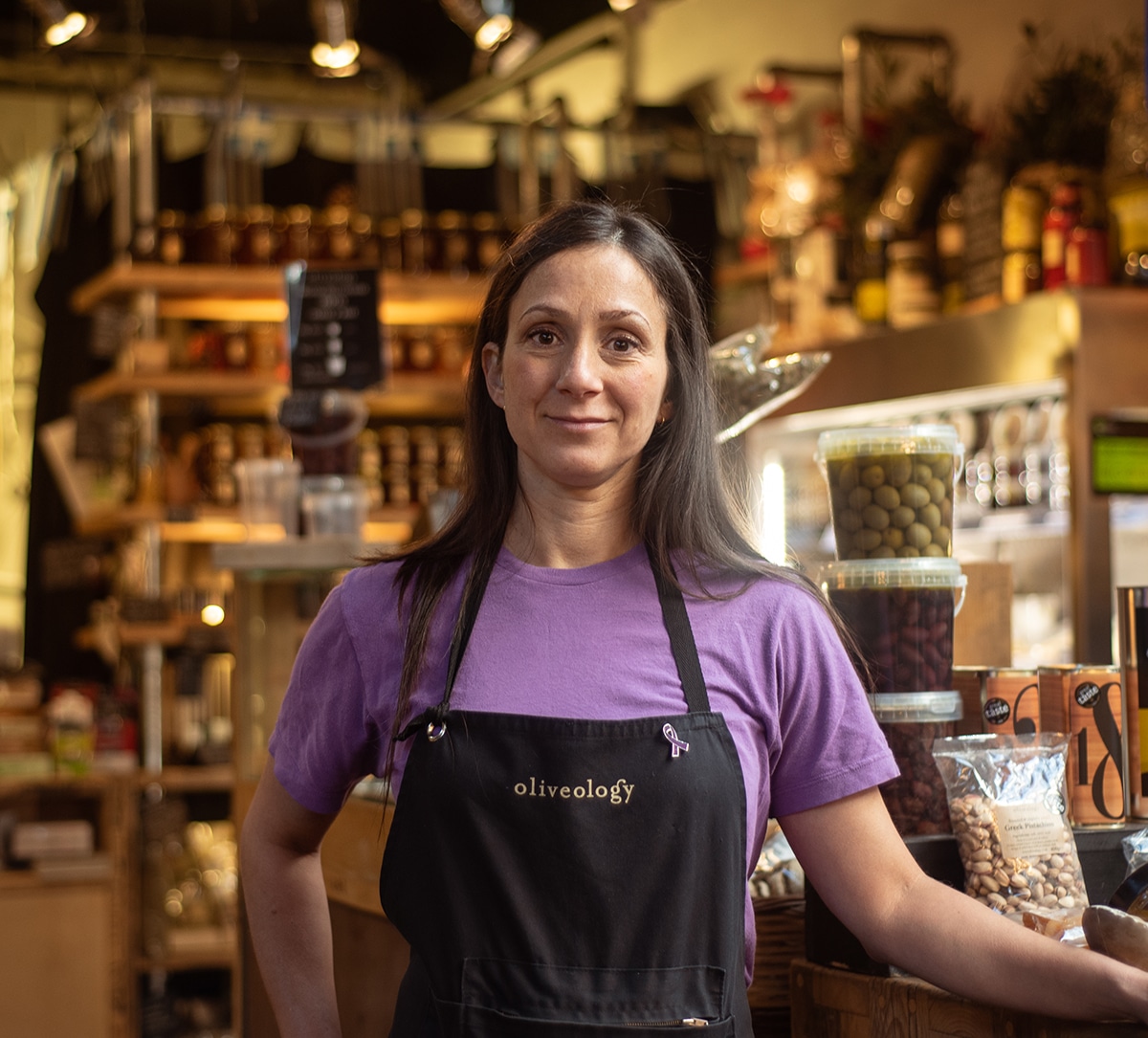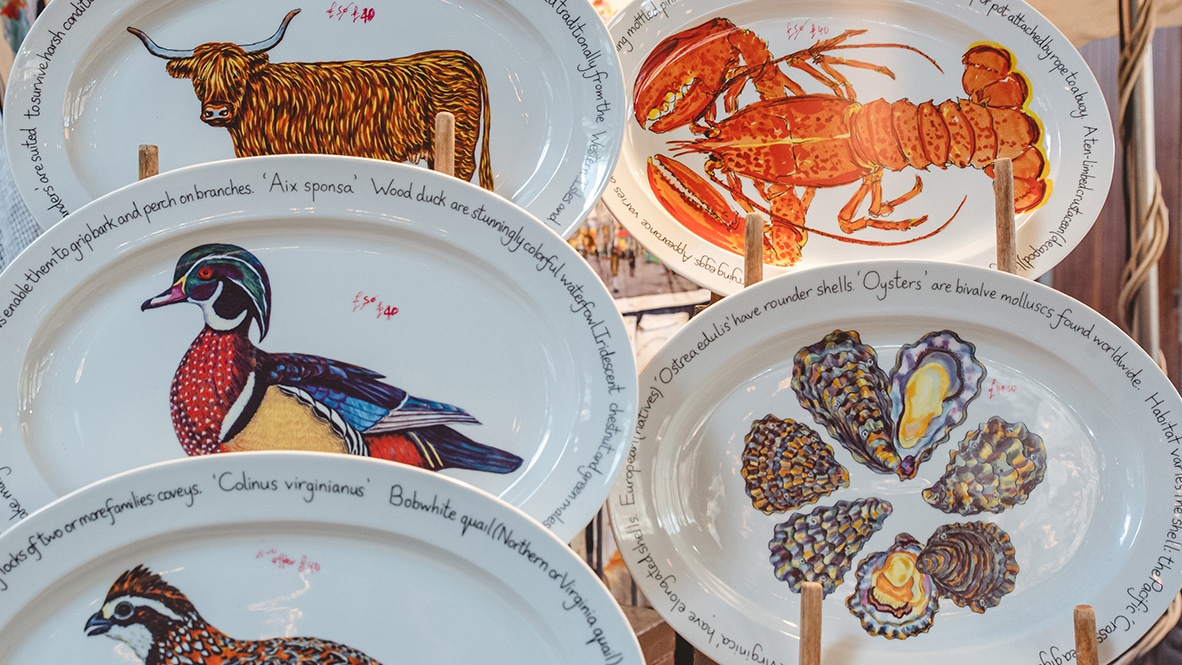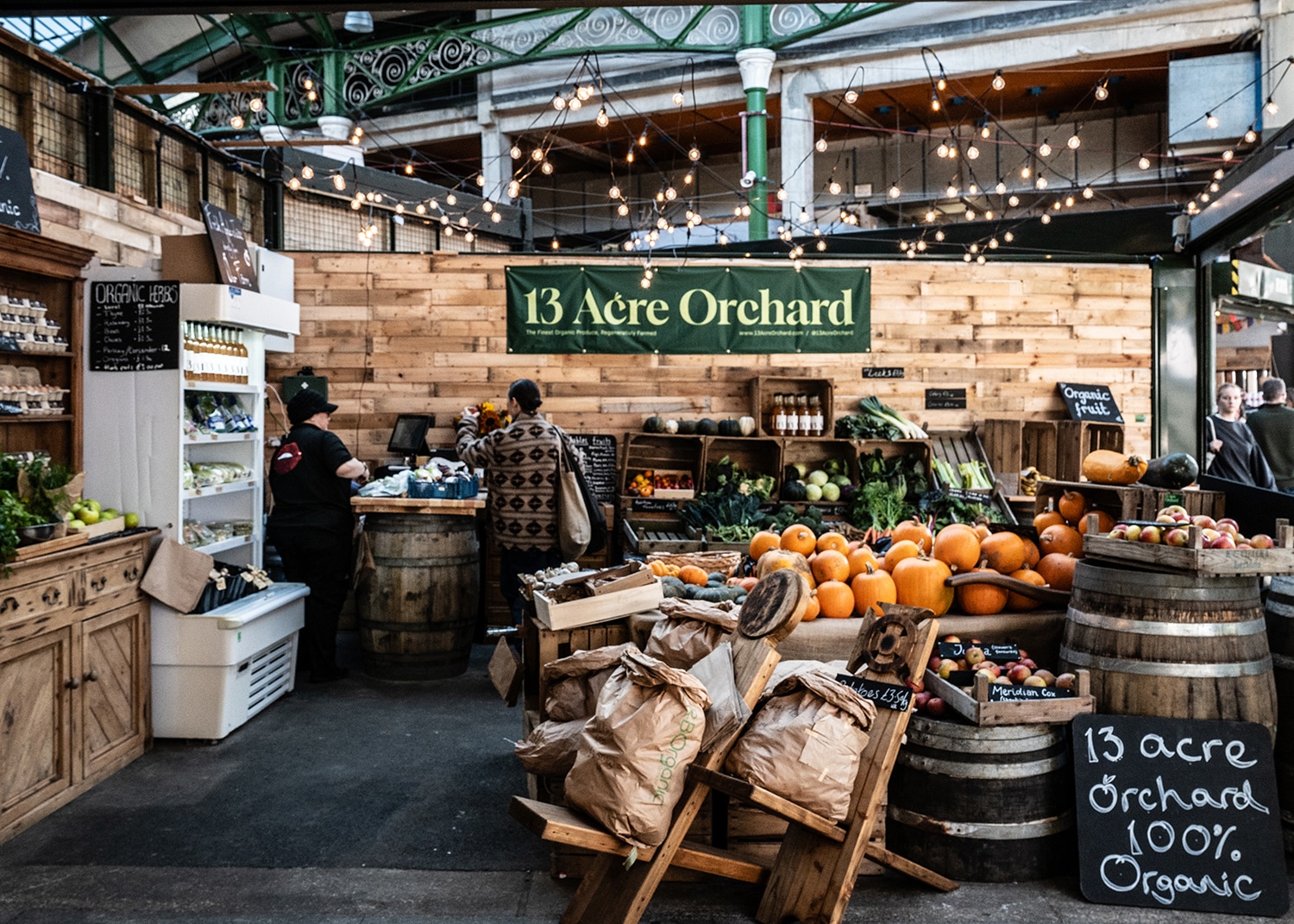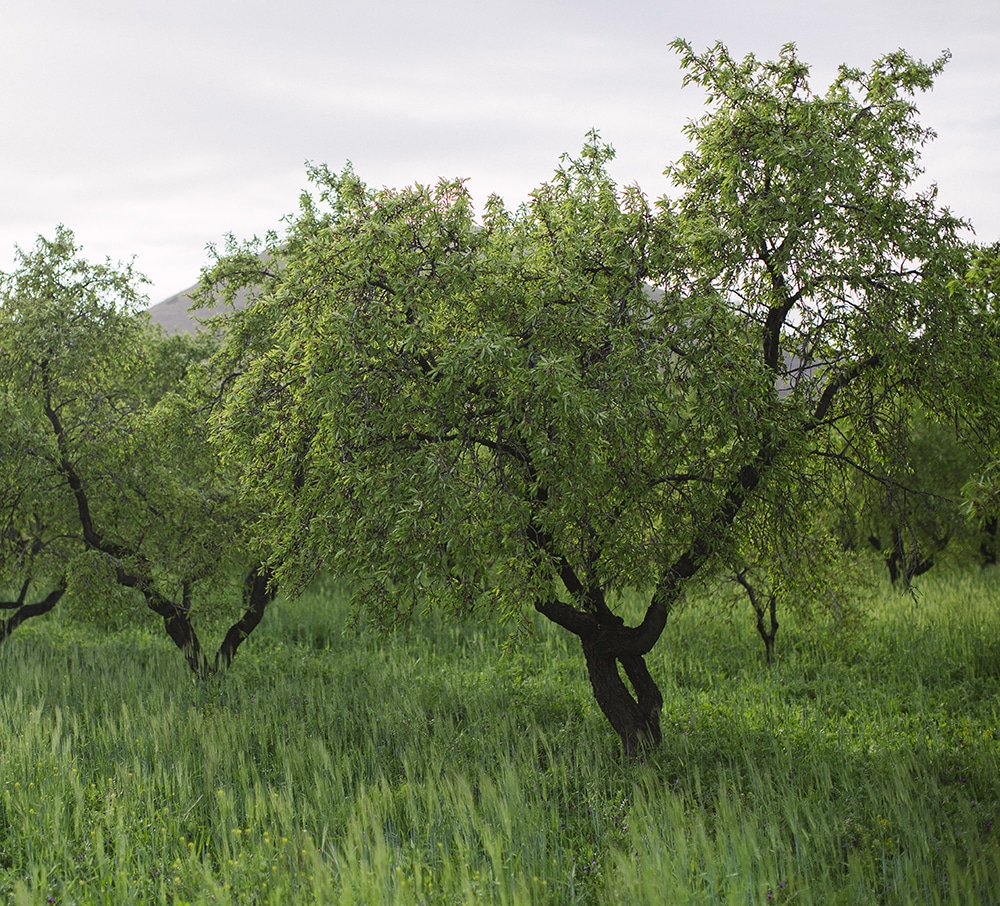Scoring points
Kathy Slack on the tricky art of growing asparagus
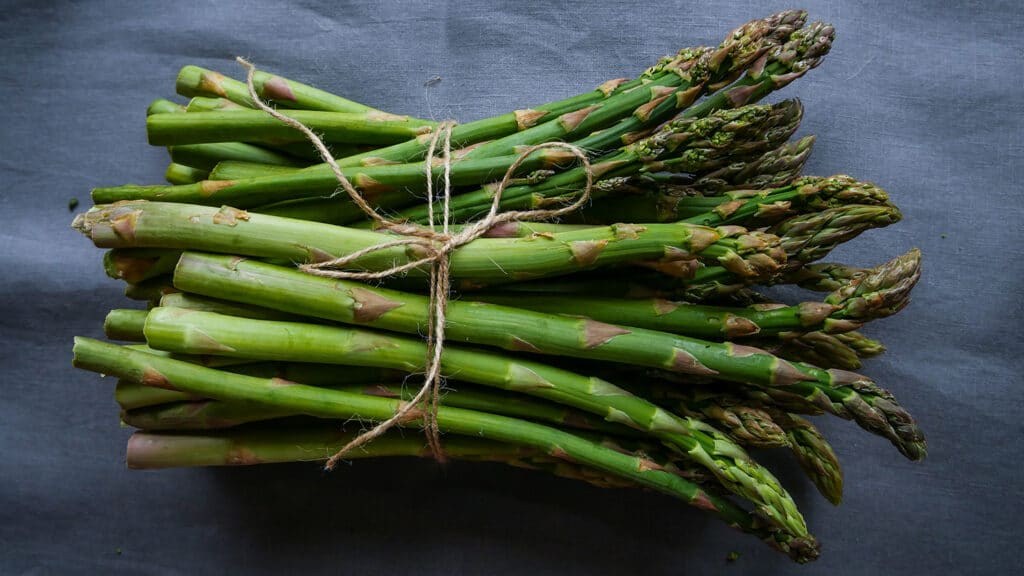

“GROWERS MUST EXERCISE SUPERHUMAN RESTRAINT AND STOP PICKING BY JULY TO SECURE NEXT YEAR’S HARVEST”
It’s a late May day in the 1980s. Two old ladies in tabard aprons sit, like wizened Italian nonnas, on plastic chairs in the lay-by of an Oxfordshire A-road. One holds a cash box in her lap, the other clutches a muddy turning knife. Behind them a sparse, sandy field is peppered with fronds of asparagus ferns, swaying nonchalantly in the breeze. Pull up here with your mother on the way home from school, and these gingham-clad keepers of the keys will waddle off into the field, joints creaking, and return with fistfuls of fresh, young asparagus for your supper.
This, for me, offered an early realisation of why some harvests are so prized and their season so fleeting. As a grown-up, encouraged by the memory of those halcyon days, I attempted to grow asparagus myself, but soon discovered that those old ladies were masters of a tricky art. Asparagus is technically possible to grow from seed, but most opt for planting dormant crowns, which must be left for two to three years before harvesting. It has to be picked by hand. And frequently – a spear can grow in less than a day. It needs plenty of space to grow, taking up acres of land, but hates weeds, so that expanse of bare soil must be weeded constantly, also by hand, asparagus roots being so shallow that a hoe would snap them.
And while the ferns will keep coming all summer, growers must exercise superhuman restraint and stop picking by July to allow the juvenile spears to grow into full ferns and secure next year’s harvest. As if all that wasn’t enough, they must then survive the winter without rotting in wet soil or being eaten by hungry wildlife keen to dig the dormant roots out of their shallow graves.
Unlike the growing, the eating of asparagus is best kept simple: steam and serve with butter or a soft-boiled egg. At most, wrap in prosciutto and roast for a few minutes. Or leave it raw, as in the recipe linked to below, to fully appreciate the juicy, crisp greenness of this hard-won harvest.
Asparagus, lemon & pine nut salad with garlic bruschetta
Read Kathy’s recipe, which brings to the fore the juicy, crisp greenness of English asparagus
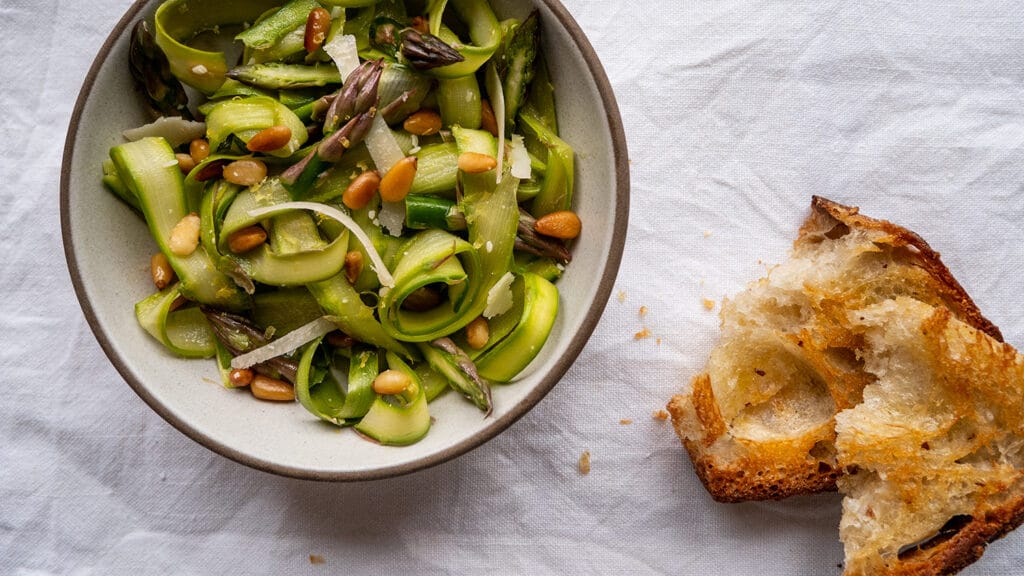
Hot tips
Bee Wilson explores the life-changing revelation that, in defiance of the old consensus, asparagus can be cooked using methods other than boiling
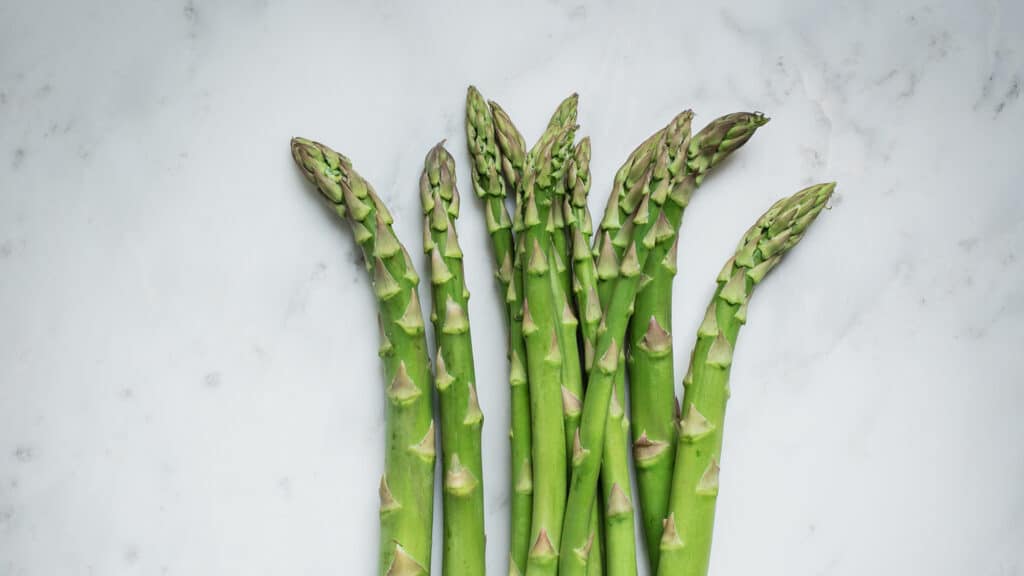

“OVER THE PAST DECADE, CHEFS AND COOKERY WRITERS HAVE THROWN OUT THE ASPARAGUS RULE BOOK”
Words: Bee Wilson / Images: Regula Ysewijn
“What if you do not possess an asparagus boiler?” asked Jane Grigson in her Vegetable Book. It is not a dilemma that troubles many cooks now. But back in 1978, when Grigson’s book was first published, everyone knew that there was only one way to cook asparagus: boiled, standing in a bundle. Not owning an asparagus boiler could make this tricky task even trickier.
An asparagus boiler – for the uninitiated – consists of a tall cylindrical lidded pan with an inner basket. The bundle of asparagus is put in the basket, stalks down, with a few inches of salted water. The idea is that in the time it takes every last bit of stringiness to be boiled out of the stalks at the bottom, the tips will steam to tender-crisp. To readers who did not possess this elaborate vessel, Grigson suggested improvising an equivalent using some other tall saucepan and a “wire blanching basket”. As for those who had no wire blanching basket, she recommended tying the asparagus in a bundle in a normal saucepan and improvising a domed lid of foil for the tips. The one thing Grigson did not suggest was cooking this sublime spring vegetable by any other method, because back then boiled asparagus was seemingly the only option.
Thinking about asparagus, it struck me that modern cooks express our love of ingredients very differently from cooks of yesteryear. In the past, asparagus-lovers worshipped this expensive vegetable by cooking it in one way only, which almost seemed to be demanded by the anatomy of the plant. To respect asparagus was to know that it needed to be kept in a bundle and boiled upright, with obsessive care for not overcooking the tips. By contrast, cooks now celebrate the all-too-brief season of these green vibrant spears by cooking them in as many different ways as possible. We griddle asparagus and we braise it; we shred it and eat it raw; we toss it with pasta and noodles; we use it to add spring freshness to green minestrone or risotto.
Cooks used to signal that an ingredient was special by cooking and serving it in one particular way and often in a single designated vessel. Turbot, for example, was poached in court-bouillon in its own special turbotiere. Hot salmon called for hollandaise and cold salmon for mayonnaise. And asparagus, prince of vegetables, demanded to be gently scraped to remove any tough outer stalks, then cooked in water.
There are 19 asparagus recipes in Haute Cuisine by Jean Conil, first published in 1953, and except for one recipe for green asparagus soufflé, all of the others consist of boiling it and serving hot or cold with a sauce. Many of these old haute cuisine ideas for boiled asparagus are in fact still lovely. Conil’s suggestions for asparagus sauces include ‘Maltaise’, a tangy hollandaise made with blood orange instead of lemon and a simple fresh cream sauce sprinkled with chopped chives and chervil. I am a big fan of Conil’s ‘asperges Espagnole’: hot asparagus served with poached eggs and vinaigrette.
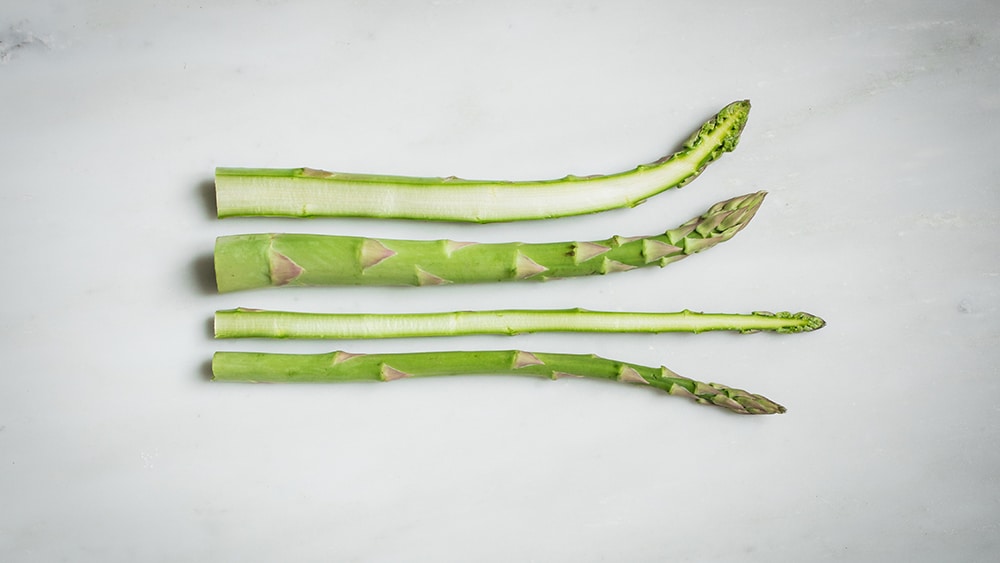
When I started cooking in the 1990s, I was firmly of the boiled asparagus school. Someone gave me an asparagus boiler for a wedding present and I was determined to master making proper bundles, like a Dutch still life. I knew that some recipe writers had started blackening asparagus on a char-grill, but the first few times I tried it this way, it tasted harsh and burned and half-raw, a waste of those expensive spears. So, I persevered with my asparagus boiler, even though I found the process frustratingly hit and miss. As Jane Grigson said, depending on the size and quality of the asparagus the timing could vary “from 15 minutes to 45”, which made it impossible to plan supper.
The recipe that changed the way I thought about asparagus was River Cafe penne with asparagus carbonara, which I first read about in 2000. This was a carbonara, but with spears of asparagus cut on the diagonal in place of the pancetta. The thing that startled me was the wondrous economy of the method. While the pasta boiled until al dente for nine minutes, you cooked the asparagus in a separate pan. The stalks were added first, then after two minutes, the tips, which cooked for a further four minutes. The blanched asparagus is tossed with pasta, egg yolks, parmesan, butter and thyme to make a richly spring-like dish: green and golden.
The first time I made it, I couldn’t believe that the asparagus had come out so perfectly with so little effort. I never used my asparagus boiler again, realising that I could boil the spears unbundled in a big pan for five minutes, with none of the fuss and better results.
Over the past decade, chefs and cookery writers have developed a much more experimental and playful approach to asparagus. We have thrown out the asparagus rule book. Take the controversial question of snapping versus slicing. Many cooks used to swear by the tradition of snapping each stalk to separate the edible top from the inedibly woody bottom. But in 2009, food writer Harold McGee experimented by snapping 130 spears and found that the snapping method was far less reliable than simply looking at the spears and cutting them at what seems to be the right point. Don’t discard the stalks. Much of the bottom part is still edible too, notes McGee, if you slice it very thinly and add it to a soup or stir-fry.
It was Yotam Ottolenghi who convinced me that chargrilled asparagus could make a welcome change from plain-boiled. Freshly harvested asparagus contains a lot of natural sugar and charring it accentuates both its sweetness and its umami flavours. Ottolenghi’s first cookbook contained a recipe for chargrilled asparagus, courgette and halloumi cheese salad. It was a bit of a palaver to make: the asparagus was blanched before it was charred with thin slices of courgette and anointed with garlicky basil oil. But the firm, bright spears took on a savoury depth that was a revelation. I have since discovered that I like charred asparagus even more if it is sliced up, tossed with salt and oil and browned for between five and 10 minutes under a very hot grill, with lemon zest added at the end.
If you don’t try different things out, you will never know what you’re missing. As J Kenji Lopez-Alt of The Food Lab writes, we should embrace asparagus “in all its forms from raw and crunchy to braised, olive-green and totally tender”. The best of all ways to cook asparagus, I am now convinced, is neither boiled nor grilled, but braised. By braising, I mean browning the asparagus in a single layer in a paella pan or similar before cooking with butter and a splash of water or stock until the liquid emulsifies to a glossy sauce, which takes less than 10 minutes. Braised asparagus offers both the browned intensity of charred asparagus and the delicacy of boiled.
My introduction to braised asparagus was Lopez-Alt’s excellent recipe on the Serious Eats website but I also recommend the Patricia Wells version on the Food 52 website, where the asparagus is flavoured, surprisingly, with rosemary and bay. With middle age, asparagus season has started making me feel wistful. It lasts such a short time, and who can say how many more asparagus seasons remain? This is yet another reason to expand your horizons beyond boiled asparagus. Not possessing an asparagus boiler is no loss. The real pity would be to miss out on squeezing every ounce of asparagus-joy from the season before it is gone.
Discover more
The herb guide: wild garlic
Ed Smith, author of The Borough Market Cookbook, looks in depth at the many fresh herbs available in the Market. This time: wild garlic
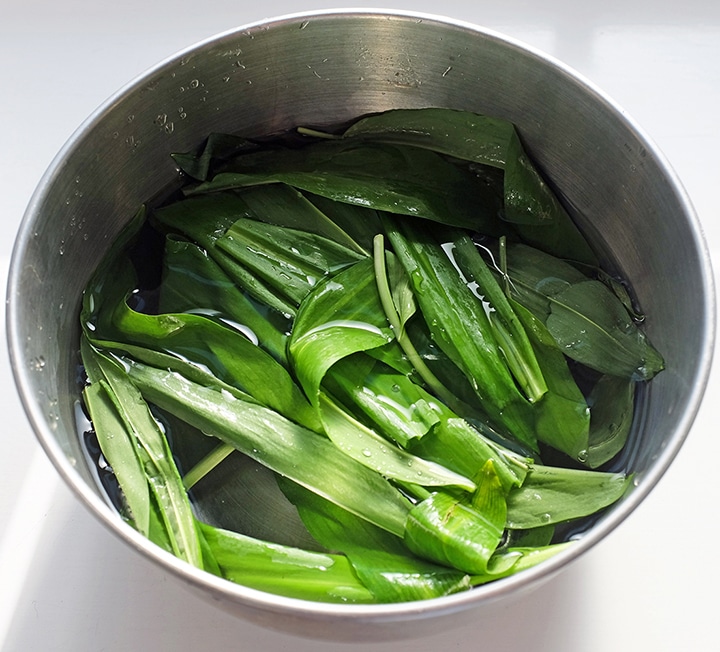

“USE RAW WILD GARLIC SPARINGLY – IT MIGHT LOOK MILD AND DELICATE, BUT BOY DOES IT PACK A PUNCH”
Image: Ed Smith
I recently realised that I’ve never really covered the question of what makes a herb a herb. That realisation struck when I was pondering whether wild garlic – or ramson, as it is otherwise known – qualifies for inclusion in this series.
As it happens, I determined well before getting too bogged down in detail that, regardless of the true definition of ‘herb’, these pungent allium leaves should be included on a matter of practicality: despite their ‘wild’ nature, we increasingly see these long, wide, pointed, vivid green leaves on the grocer shelves next to chives, coriander, mint and so on. They carry and impart an incredible flavour, and over the last few years have become an essential part of the British cook’s springtime larder.
In any event, after a spot of foraging through botanical guides and dictionaries, it’s clear that wild garlic fits technically too. A herb is defined as “any plant with leaves, seeds, or flowers used for flavouring, food, medicine, or perfume”; and “any seed-bearing plant which does not have a woody stem and dies down to the ground after flowering”. To my mind at least, wild garlic fits both of those.
Wild garlic grows in moist soil, usually under partial cover of deciduous but not yet leafy trees (often near to bluebells). The season runs from around March to May, depending where you are in the country. You’ll easily identify a patch of wild garlic as there’ll be more than a hint of garlic in the air – it’s a bit of a give-away. Moreover, towards the end of their season, a flurry of beautiful six-pronged white flowers highlights their presence.
Storage
Whether you’ve found and picked the leaves yourself, or bought them from a grocer, my advice on storage remains the same: use them as quickly as possible. Wild garlic leaves wilt in moderate heat and bruise easily too, so it’s best just to pick or buy a few of them, and in short order.
You should store the leaves in the paper or plastic bag or plastic box that you buy them in (or put them in something similar if you did the foraging). Then put them in the fridge.
I tend to then ‘refresh’ the leaves in a bowl of very cold water before using them. Or, if on the same day and I’ve space in the fridge / kitchen, I’ll cut out the middle storage process and just leave the leaves in the water until required.
Don’t bother trying to dry garlic leaves. You could, though, make an oil as per the chive oil in my previous post. Or beat into butter, roll in clingfilm and freeze until your wild garlic butter is required.
Cooking tips
There are three ways to use wild garlic in your cooking:
The first is raw as a chopped garnish. Slice finely with a knife and sprinkle is probably the best advice to give here. But use raw wild garlic sparingly – it might look mild and delicate, but boy does it pack a punch.
The second is to wilt the leaves in a little butter or oil, or very quickly blanch them. This quick application of heat mellows and rounds the flavour of the herb. It’s also my preferred way to use it – it’s so powerful when raw that you’d struggle to get through all of the garlic you’d picked or purchased if you only ate it in its fresh state.
Finally, many chefs will pickle wild garlic (called ‘ramps’ in the States), and add it as a punchy seasoning to numerous foods throughout the year.
Oh, one other thing: do use the flowers if you have them – they also carry a delightful garlicky flavour. Keep them raw and just sprinkle over your dish at the last minute; they’re not as harsh as the leaves, and they sure are pretty.
Classic uses
In terms of flavour pairings, it’s hard to say what ingredients you wouldn’t match wild garlic with (except sweet things). Basically, where normal garlic goes, wild garlic will too. That said, the likes of white fish, salmon, lamb, beef, eggs and wild mushrooms are particular fans.
It wouldn’t be correct to state that wild garlic has particular ‘classic uses’ in the same sense of many of the Mediterranean herbs covered in this series. However, well established uses and flavour combinations include:
— In a pesto, pistou or picada, obviously swapping normal garlic for the flavour in the raw leaves. You’ll see some recipes that completely substitute wild garlic for basil or parsley leaves too. But for me, this is too much. I’d keep a handful of either of those two herbs in the mix to mellow the effect of the garlic.
— As part of a sauce vierge (green sauce) mix alongside tarragon, parsley, capers, anchovy and a splash of red wine vinegar.
— Blanched at the last minute with asparagus.
— Beaten into a butter to melt over griddled beef steaks and lamb chops, or place within a wild garlic chicken kiev.
— Stirred through creamy risottos.
— Cooked in an omelette or with scrambled eggs.
Market herb hero
Any of the grocers stocking the herb – you’ll find it at Fitz Fine Foods and Turnips (and probably the other grocers too from time to time) – plus Neal’s Yard Dairy who, towards the end of the wild garlic season and then for a month or two after, may well have the wild garlic-wrapped version of Lynher Dairy’s Cornish yarg.
A recipe suggestion
Try my wild garlic & new potato frittata: because of its short shelf-life, I prefer to use as much of the wild garlic in my possession at the same time as possible, which usually means applying a bit of heat to mellow the flavour. One way to do that is to use a good bunch of the stuff in a frittata.
What it takes: foraging
Noel Fitzjohn of Fitz Fine Foods on location-spotting, constant vigilance and the menace of dogs


“LOCATION IS EVERYTHING. IF YOU WANT THE BEST PRODUCE, YOU NEED A LOCATION WITH THE IDEAL CONDITIONS FOR THE PLANT”
Interview: Viel Richardson
How did you come to be a professional forager?
When I started Fitz Fine Foods, foraging was never meant to be a major part of the business. We were making mostly pâtés and terrines, and I wanted to ensure that the ingredients we were using came from people whose methods were environmentally sensitive and sustainable. I had been foraging for myself for years, and some of that produce occasionally made it into my products. When I analysed what people were buying, the two most popular areas were our small selection of mustards and anything based on foraged plants. I decided to find a way to combine the two. That led to a range of flavoured mustards using foraged goods.
What is the key to being a successful forager?
Location is everything. If you want the best quality produce, you need to find a location with the ideal conditions for the plant. Plants can often gain a foothold in less than ideal places, but they will not be at their best, so you need to know and understand the environments in which they really flourish. Another big issue is dogs: if you forage in areas favoured by dog walkers, it is inevitable that your favourite patch will one day be used as a dog latrine. Essentially, any public land where dogs are common is off limits, so I mainly forage on private land.
Is that legal?
The laws around trespass and foraging have some grey areas, but from my perspective one thing is crystal clear: if you forage on private land for commercial purposes, you have to obtain the landowner’s permission. Tracking down the owner of a piece of land can be tricky, but it is absolutely essential. One place I go, which produces really wonderful wild garlic, is a private wood used for timber; the wild garlic plant is so out of control that it’s actually a real problem for the owner, so he lets me take as much as I need.
How laborious is foraging?
Anyone who has harvested plants commercially by hand will tell you it is hard work. If we take wild garlic as an example, I will gather for about three hours. That sounds a lot, but the idea is to never clear too large a patch. If you do, other plants like dog’s mercury and cuckoo-pint may colonise the area, crowding out everything else. I will clear a patch about two metres square and then move somewhere else – that way the wild garlic can recover. It is all about preserving the resource. You also have to be very observant and inspect the leaves as you harvest – while you’re not picking the leaves individually, you are glancing at each one.
What happens to the wild garlic once picked?
I wash the leaves in a large vat before inspecting them again. I then lay the leaves out to dry, before inspecting them a third time. I just want to make sure nothing else has crept in. After that, if I am going to make a mustard, I blanch the leaves like spinach; if it is for a pesto or for sale as leaves, it is left raw.
This all seems very time consuming.
Very much so. If you want to do it well, it has to be. That means that I cannot do all the foraging myself, so I do have to buy in produce from other foragers. If you’re going to stock produce that people want, you have to be able to offer it to them most of the time. They will forgive an occasional absence, but to build a stable customer base you have to offer some consistency. This is particularly relevant to me, as I make all the mustards myself, so I simply do not have the time to seek out locations, then forage and process everything I need.

How do you pick suppliers?
You do your research and assess the produce they offer. You really need to know how they operate. To give one example, some samphire pickers are paid by weight, while others are paid on quality. Lower quality, older samphire has wooden stalks in the centre, making it heavier – so if you’re paid by weight, there’s an incentive to pick the lower quality plant. You also need to make sure the suppliers are foraging sustainably. Luckily there are some very good companies out there. It is this mix of self-foraged and carefully bought produce that allows me to consistently offer high quality products.
Where do you get your recipes?
Most of them I create myself through experimentation – trial and error. To get the wild garlic pesto recipe nailed down took about three seasons of honing. There are some happy accidents. One day, some chopped-up wild garlic was left in a pot with some honey by mistake. I found it after a while, tasted it and thought it was quite nice, so tweaked the amounts and made some experimental batches – that is now a product. It turns out it takes quite some time to mature – the longer you leave it, the better it gets. If I had tried it straight away, it would have gone in the bin.
What foraged produce will be appearing as spring unfolds?
As you would expect, this is a time when a lot changes – and it can also be very unpredictable, depending on the vagaries of the weather. As our weather gets more unpredictable, you will often find things that the ‘books’ say are out of season. With the wild mushrooms, I’ll be harvesting St George’s, chicken of the woods and the scarlet elf cap, which is a really beautiful, bright red mushroom. Three cornered leeks should be making an appearance, as well as wild asparagus, marjoram and wild alexanders.
Blessed are the cheesemakers: Paski sir
Clare Finney tells the story behind a unique sheep’s cheese from Taste Croatia
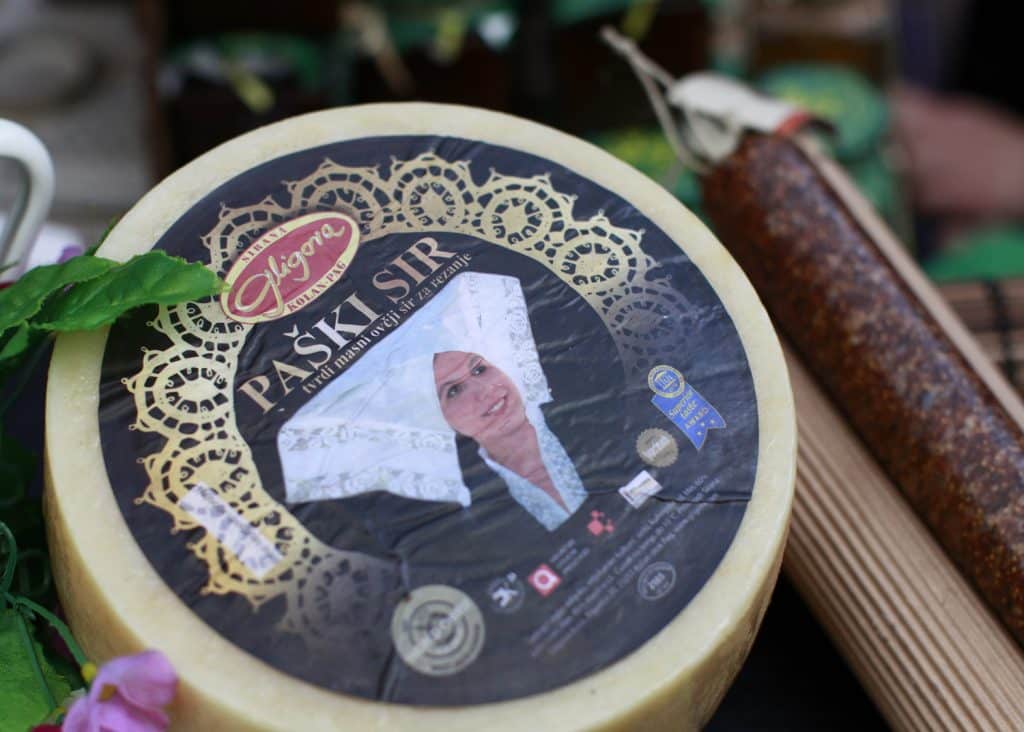

“IT’S PRETTY SALTY BUT ALSO PECULIARLY AROMATIC, THANKS TO THE PASTURES OF PAG UPON WHICH THE SHEEP FREELY ROAM”
“The bora, the sheep, the man, and the island of Pag.” That, writes Šime Gligora is the recipe for Paški sir, a cheese from the Island of Pag. A cheesemaker of world renown, Šime is the third generation to run the eponymous Gligora dairy on this weather-beaten island, where a sunny Mediterranean climate meets the harsh, cold conditions of the snow-covered mountains above the Adriatic Sea.
Their clash sparks a strong wind – the bora – which, rolling down the southern mountain slopes to meet the sea, creates a thick, dense fog of salt water drops that spreads over the island. As it dries, Pag is coated with a white dusting of salt in which only the sturdiest of herbs can flourish: sage, immortelle, cistus, fennel and Jerusalem thorn, upon which the island’s native sheep graze freely.
There aren’t many livestock capable of braving the combination of this dry and salty diet and the bitter bora, but according to Šime, the Pag sheep have been coping since at least 800BCE, when the Liburni, an Illyrian tribe, were (likely) some of the first farmers here.
Then, as now, milk and wool were vital parts of Pag’s economy. Together with salt and honey infused with the sage that grows in abundance on the salty soil, one of the most important exports throughout the island’s history has been its cheese. In 2005, conscious of the uniqueness of the Paški sir cheese and its value to the island, a number of Pag’s most established dairies formed The Association of Pag Cheese Producers, in an attempt assure the authenticity of the product.
Milk has to be from autochthonous Pag sheep milked from January to June by the island’s shepherds, who bring the milk to gathering points for it to be stored and cooled. From there, it’s to the dairy, where it’s pasteurised, coagulated and cut, allowing the mass of cheese curds to form. These are put into moulds and pressed for several hours. The cheese is then salted and left in liquid brine for a few days.
Needless to say, it’s pretty salty – but also peculiarly aromatic, thanks to the pungency of the doughty plants that pepper the pastures upon which the sheep must, according to the association’s rules, roam freely. The cheeses are ripened on special shelves in a mild, humid environment for anything from 60 days to two years, though at Taste Croatia most are six months old. During that time, the cheese producers turn, wash and oil the ripening cheeses every day.
The result is a cheese that looks a little like parmesan. Hard, candle-yellow and granular, on first bite even the taste seems indistinguishable. Then something new and unexpected kicks in. It’s a flavour that’s sturdy, vegetal and savoury; there’s salt, sure – but there’s a definite sense of sheep blowing in with it, adding an extra layer of complexity.
“We serve it to customers with fig chutney, which works very well, even though chutney is more of an English thing than Croatian,” explains Taste Croatia founder Chris Stewart. “There they serve it with charcuterie on boards, drizzled with nice Croatian olive oil.” It also pairs well with wine, he continues – another product for which this veritable pantry of a country deserves more acclaim.
In conclusion, it’s versatile. Though noticeably different to parmesan, there’s nothing to stop you grating Paški sir on your pasta or serving it ‘a l’Italia’ with a drizzle of syrupy vinegar – though naturally, we recommend you try Croatia’s fig vinegar over balsamic. “It’s won a gold medal two years in a row at the World Cheese Awards, so it’s pretty good,” says Chris, but the only proof you really need is in the sample he’ll give you, slathered with sweet, figgy chutney. “We like to get the customers a bit messy,” he grins.
The Easter feaster
With the help of Borough Market’s cosmopolitan cast of traders, Ed Smith takes a look at Easter culinary customs from around Europe
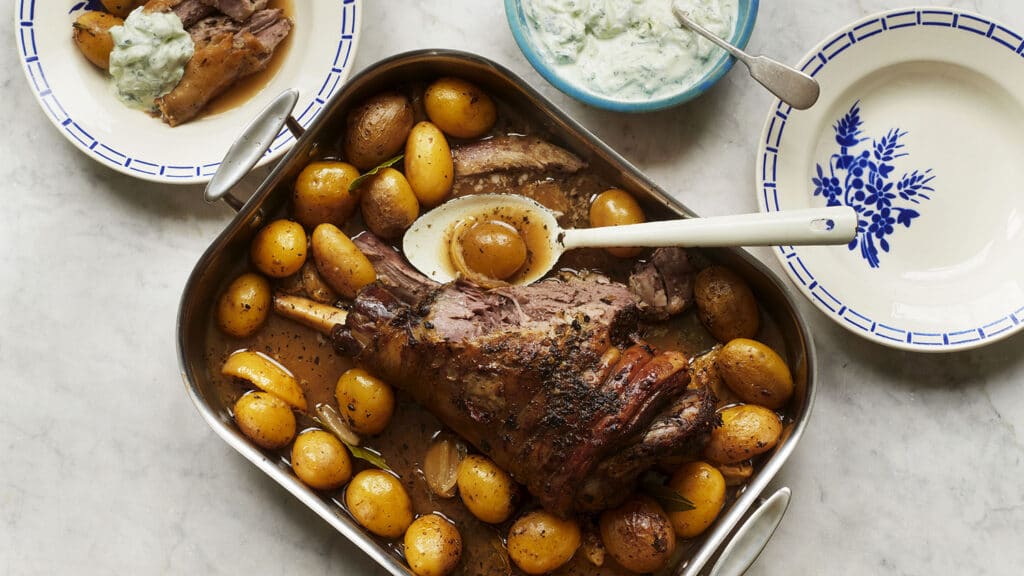

“CHATTING TO TRADERS FROM AROUND EUROPE, EASTER SUNDAY MEALS HAVE ONE THING IN COMMON: THERE IS MEAT”
After the fast
Traditionally, Christians have observed a period of fasting for the 40 days between Ash Wednesday and Easter Sunday (although it’s usually a little more than 40 days because Sundays aren’t included). This mirrors the time Jesus spent praying, fasting and resisting temptation in the desert, before returning to Galilee on the arrest of John the Baptist.
Today, strict observance of the sacrifices of this period is relatively rare; certainly in the UK now, most people who mark Lent at all tend to deny themselves a small luxury, rather than fully fasting. However, many denominations and cultures do still give up meat, dairy and eggs for some or all of the period (in particular Ash Wednesday and all Fridays). Moreover, those traditions do continue to inform contemporary eating, in particular around the period from Good Friday to Easter Monday.
Across Europe, and in other countries and communities where the more traditional Christian faiths are followed, it is the case that most people will centre a Good Friday meal either around vegetables or fish; that eggs and dairy will play a key role through the weekend; and that on Easter Sunday, to break the fast, there will be a meaty (frequently lamb) centrepiece. We also see a wide variety of sweet, dairy-enriched, leavened breads being consumed over the period.
Fish
Some Catholics abstain from eating meat on Fridays throughout the year. For others, that abstinence is more strictly observed on Ash Wednesday and Fridays through Lent. Fish flesh, however, is different, and so the tradition of eating fish on a Friday has informed European diets for millennia. In the UK ‘fish on a Friday’ is a societal habit that now goes beyond religious observance. The same is true elsewhere, so inspiration for a fishy Good Friday feast this Easter is plentiful, if not particularly prescriptive.
Walking round the Market there are plenty of ideas – starting, of course, with grabbing a fish pie mix from the fishmongers. Maybe pick up some tortillas and make Mexican Baja fish tacos. Or buy some salt cod from Brindisa and try this salt cod pil pil recipe – succulent, flakes of cod under an oily blanket, just wonderful with roasted peppers.
Eggs
Of course, we Brits know that Easter means eggs! It’s just that, in relatively recent times, those eggs have become chocolate ones, and probably fairly divorced from the meaning still appreciated elsewhere.
Eggs are symbolic. At a base level, they represent new life and rebirth, and so are a timely ingredient at this time of year. The tradition of foil-wrapped chocolate eggs evolved from painted or died Paschal eggs being given as gifts. The link also runs deeper in some cultures, with the egg seen as a representation of Jesus’s tomb, and eggs being stained the colour red – as the blood of Christ.
Marianna from Oliveology recalls that at home in Greece it is customary to stain eggs using natural dye (a packet version of which she sells at her stall). Those eggs can be blessed at a midnight service on Good Friday, and often sit decoratively atop braided breads. Having been forbidden during Lent, they’re also made use of with gusto over the weekend, for example in galatopia, a delicious egg, semolina and milk pie – we’re lucky that Marianna has kindly shared with us her mum’s recipe for that.
No doubt, eggs will feature over your Easter weekend. We like them for breakfast Slavic style, with horseradish cream and rye bread.
Breads and cakes
Speaking with Borough Market traders from around Europe, it was interesting to find that, as in Britain, there tend to be few absolutely prescriptive dishes or meals over the Easter period. It is more the case that people follow hyper-localised (or even familial) interpretations of the general themes discussed in this piece. One of the themes to bring the broadest smiles is that of enriched, sweetened, leavened breads.
The tradition for such breads arises (pun intended) for multiple reasons, including the deep-seated Judeo-Christian significance of breaking bread, and the symbolism of the leavening reflecting the resurrection.
In Britain we have hot cross buns. Elsewhere there’s Greek lambropsomo and tsoureki: soft, fluffy, aromatic braided bread with a golden-brown crust. Another example of Easter bread is Italian pane di Pasqua, a brioche-style bread likely decorated with bright sprinkles and braided to look like a nest holding a colourful died egg.
There’s also colomba di Pasqua – a cake not dissimilar to panettone, in the shape of an Easter dove – which you’ll find at Gastronomica.
A meaty centrepiece (or not)
And so to the Easter Sunday meal.
Chatting to traders with links to Spain, Italy, Croatia, Greece, eastern Europe and elsewhere, we all have a common response to the traditional Easter meal: “Yes… there is meat.” However, few of them cited anything as specific to the occasion as the British Christmas turkey and trimmings, or Italian braised lentils and cotechino at New Year.
The meat is often lamb, although obviously where lambs are not common, it might very well be veal or pork instead. As in the UK, the lamb will generally be cooked quite simply – roasted, grilled or barbecued. It’s typically a large joint or, in countries like Spain and Greece, a whole milk-fed lamb, no doubt because the meals in which it is eaten tend to be relatively large family gatherings.
Marianna mentioned that this year she’ll be back in Greece for the first time in a long while, enjoying all her family customs, including barbecued lamb. Given that sunshine is more likely guaranteed for her than it is for us, we suggest sticking to a more classically British roast leg of lamb, but adding hints of Greece through dried oregano, lemon and bay potatoes, and generous splodges of tsatsiki.
That said, if you or others around the table plan to abstain from red meat for just a little longer, try an artichoke torta Pasqualina. Again this savoury pie (from Liguria) involves the symbolism of eggs, and makes a mighty-satisfying centrepiece. It’s also excellent for an Easter Monday lunch table or picnic.
The Borough Market Guide to Easter
A cosmopolitan collection of Easter recipes, from Spanish salt cod pil pil to Italian Torta Pasqualina

Mothers of the Market
How were Borough Market’s traders influenced by their mothers and grandmothers? Clare Finney finds out
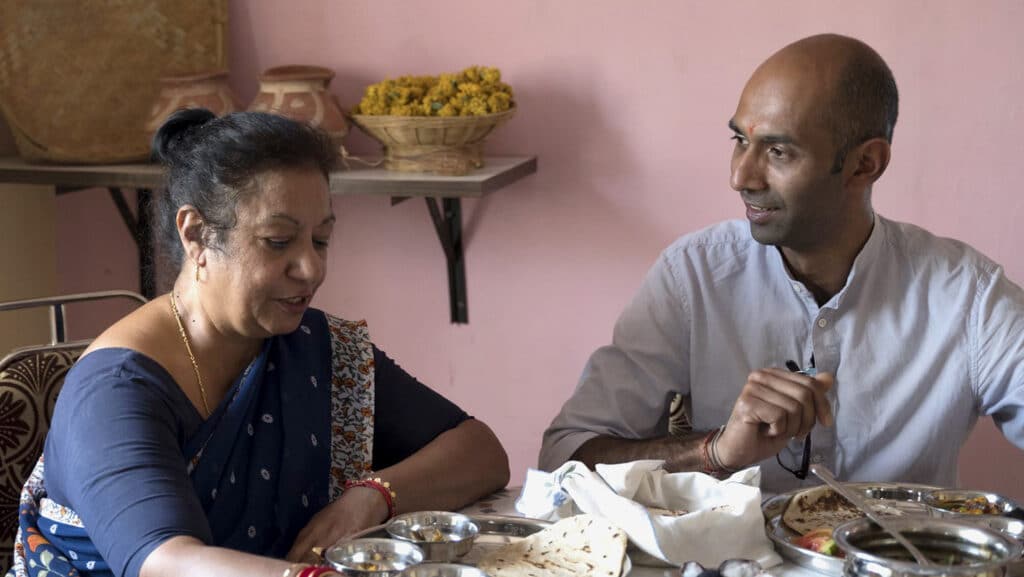

“FROM ITALIAN NONNAS TO BRITISH MUMS, THERE IS NO DENYING THE MATERNAL INFLUENCE IN BOROUGH MARKET”
Words: Clare Finney
There is a recipe my brother and I will cook all our lives; will entrust to our offspring and forever guard against outsiders. It is our mother’s cheesy pasta with peas and sweetcorn. Oh sure, it sounds easy – but only with the right pasta shape, a suitable strength of cheese and one very special, secret ingredient can you recreate the cheesy pasta of our childhood. Through it we learnt not just the trick to making a good roux and an appreciation of good cheese, but the delicate interplay between the thickness of the sauce and the shape of the pasta.
It was with this in mind that I approached Borough Market’s traders in the run up to Mother’s Day. How had their mothers and grandmothers shaped their culinary futures? What role had these women played in the products and philosophies of various stalls?
From Italian nonnas to British mums, there is no denying the maternal influence in the Market. “My mum and my gran were the greatest food influencers in my life. They taught me everything: recipes, tricks, traditions, preservations, seasonality,” says Marianna at Oliveology. In Greek culture, food is a predominantly female preoccupation, and her stall is a living testament to the influence of the women in her life: olives, olive oil, herbs and wine that she grew up on, produced on her family’s farm in Greece. “All this inspired me and guided me in the values that we want to come across, through Oliveology, to the public,” she says proudly.
Olive oil also runs in the blood of Luigi at The Olive Oil Co: “I am from Puglia. My grandmother was a chef,” he smiles, “and I remember when I was very young she would give me bread and olive oil to keep me entertained in the kitchen – and out of her way. My mother didn’t really cook. She wasn’t very interested.” His grandmother, however, would ply him with “different combinations of flavours and new recipes”.
Our mothers and grandmothers often hold sway in our relationship with food: and for that reason, it is deeply emotional. What they cook, how they cook, and how they involve us in the process forms the bedrock of our culinary lives. When Urvesh’s mother Lalita Parvais (pictured above with Urvesh) arrived in the UK from India in 1968, it was her recipes that brought her solace: the mung bean dal, chapattis and bhujia passed down to her through the generations of Parvais females. “In a winter not dissimilar to this one, food was a sensory, nostalgic journey,” explains Urvesh (pictured above with his mum, Lalita).
When he came to establish Gujarati Rasoi, it seemed only natural that he draw on his heritage – his “time capsule food” – in order to provide as true a taste as possible of rural Gujurat. “My great grandparents lived in east Africa for years before moving back to India. Then my mother and grandparents moved to the UK in the 1960s. Any alterations or twists in these recipes would automatically mean it wouldn’t have had the same nostalgic hit,” explains Urvesh.
Meanwhile, in Zambia, Bill Ogelthorpe’s parents’ attempts to recreate the dishes of their Swiss homeland were frustrated at every turn. “My mum and dad grew up in Switzerland, so they were always trying to make fondue. But there is no tradition for cheese in Zambia. The climate is too hot. It was difficult to find it.” More often than not, the Oglethorpes would be reduced to mixing “some sort of cheddar and beer, or whatever they could find,” he laughs – wine being equally rare. “The Swiss would have died if they’d seen it.” Still, the young Bill must have tasted enough potential in the melting pot for him to embark on a stellar career in Swiss-style mountain cheeses, sold at Kappacasein.
As Nigel Slater will forever attest, culinary greatness can also be born out of a quest to better your childhood experience of food. “We tried to make baguettes once. It was an absolute disaster,” grins Matt Jones, founder of Bread Ahead. “Mum was a great home cook, however: lovely Christmas cakes, great puff pastry for sausage rolls, an amazing carrot cake. She was a big culinary influence and we were always experimenting together. It made me want to get into this world.” He’s got the recipe for the carrot cake. It appeared on the stall a few years ago and may well appear again. The stories and recipes linking traders to their mothers and grandmothers are as diverse as they are many – yet one thing strikes me in particular. None of them – the chapattis, the cakes, the fondues, the koftas – are particularly complicated or unusual. “There is a dialogue that takes place between someone cooking food for someone they love and the eater, which is not verbal,” Urvesh exclaims feelingly, of his family’s hot mung bean dal. “It is affection, love, warmth, anticipation – all those things in a mouthful.” I think of mum’s cheesy pasta: zinging with peas, juicy with sweetcorn, the golden, cheesy strands stretching with each steaming forkful, and I am not just full and happy – I am home.
Q&A: Mary Quicke
Mary Quicke, owner of Quicke’s and a 14th-generation cheesemaker, on complex cultures, the importance of grazing, and why more women should be running dairies
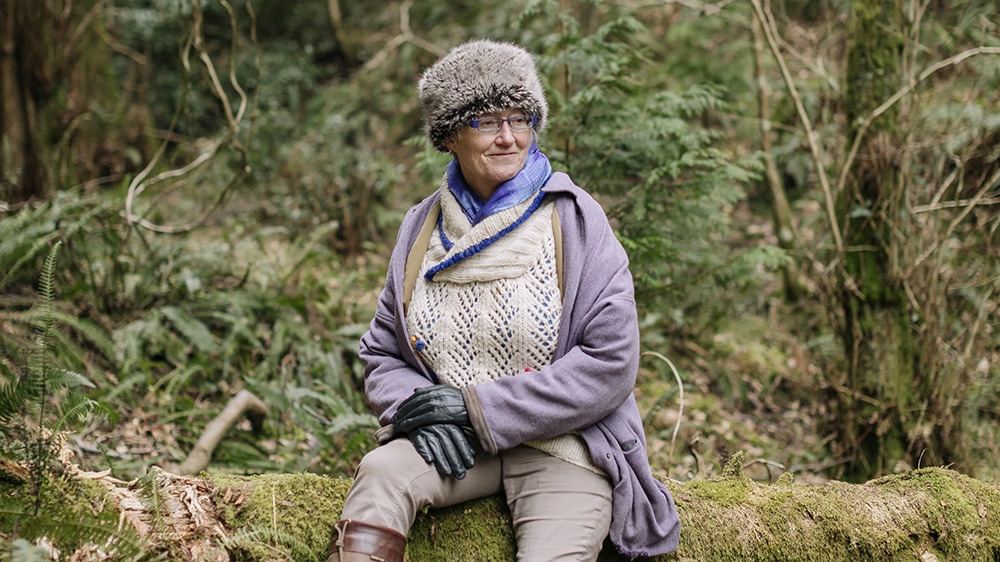

“WHEN YOU MAKE CHEESE IN A MASSIVE BLOCK, YOU LOSE THE CONNECTION TO THE PLACE IN WHICH IT’S PRODUCED”
Interview: Ellie Costigan / Images: Orlando Gili
There are very few cheesemakers in Britain more thoroughly steeped in the history and culture of their craft than Mary Quicke, the owner of Quicke’s. Her family have been farming the same beautiful stretch of land near Newton St Cyres in Devon since 1540, so dairying is in her blood as well as being something that both fascinates and excites her. Mary’s exceptional cloth-bound cheddar cheeses are sold at Borough Market by Heritage Cheese and Neal’s Yard Dairy.
You’re a 14th-generation cheesemaker. Did you always know you’d take on the family business?
I’ve got three brothers, so I always assumed one of them would take on the farm – that’s the traditional thing. My dad was very off-putting. I think he felt he’d done it by obligation, so he was very keen for us to explore other things. I ended up living in London but whenever I went back to the farm, I was just so inspired. I just wanted to come back – eventually I said, “Dad, please can I!” And he said yes. I’ve been running the business since 1987.
Your family has farmed in Newton St Cyres since the 16th century. The dairy industry must have changed a lot during that time.
In the old days, cheese used to be made in every farmhouse, because that’s how you took milk from the summer to the winter. We’ve got pictures of people making cheese on the farm in the 1920s and 1930s. But all that stopped, along with most farmhouse cheeses, during the war. At that point all milk – other than a few places that made national cheese, which was kind of a young, sub-cheddar – went as liquid to feed the population.
One day, my grandfather was told by the milk buyer of Exeter, “We don’t want your milk today Mr Quicke.” That really struck my father, as a little boy: dairy farming doesn’t work if you don’t sell your products. When he came to run the farm, he wanted to make sure he produced something that people would really want. There is always demand for cheese – it’s up to us to make sure we make it delicious. My mother – who’d been told during art school that her training allowed her to do anything – built the current dairy in 1972, while raising six kids. My parents wanted to make cheese the old-fashioned way.

What makes your traditional farmhouse cheddar different to the mass-produced stuff?
We pasteurise our cheese, but otherwise we are very much still making it the old-fashioned way. The milk is 100 per cent from our own herd; we use heritage starters; we hand-cheddar, which is the process of stacking up the blocks of whey. When it’s made on an industrial scale, you’ve got these things called CheddarMasters, where a huge amount of whey is turned over very slowly in a waterfall-like motion, which produces a different result. Every teeny-weeny thing you do, every decision you make, affects the outcome of the cheese. The mantra of Malcolm, our cheese manager, is: “Do it as it’s meant to be done.” Industrialising is about putting less work into it. When you make cheese in a massive block, you lose something – the connection to the place in which it’s produced, that interaction with the environment.
How intricately linked are the environment and the flavour of the cheese?
Cheese is like wine; it’s a real expression of the terroir. Milk or cheese produced even just 10 miles away will taste different to ours. In our cheese store – our cheese cathedral! – what we’re doing is growing a mould garden. Those moulds make a real difference to the flavour of the cheese. We did a swap with James Montgomery in Somerset – put two of our cheeses in his storage, two of his in ours – just to see what effect it had. The difference was profound. Cheesemakers from other farms come here, we show them what we do, and we absolutely know that they won’t end up with the same results.
Cheese tells the story of the place it’s come from. We love coming to Borough to see people learning about our cheese. What’s fantastic about Borough Market is, every one of those foods has a great story. You can cross the wavy bridge from the heart of the financial centre, where it’s all about business and money, and there in the Market people are thinking about soil, about mould. It’s extraordinary.
The word ‘consumer’ encourages you to be passive – to be on the receiving end of a huge chain, as opposed to choosing on the basis of knowledge, after proper consideration. But if you eat with knowledge, you’re absolutely in the driving seat. You can, as Slow Food says, be a co-producer. Your buying decisions make a difference – you’re funding that place. In so doing, you’re impacting the people there and planet you live on. I think that’s enormously empowering.
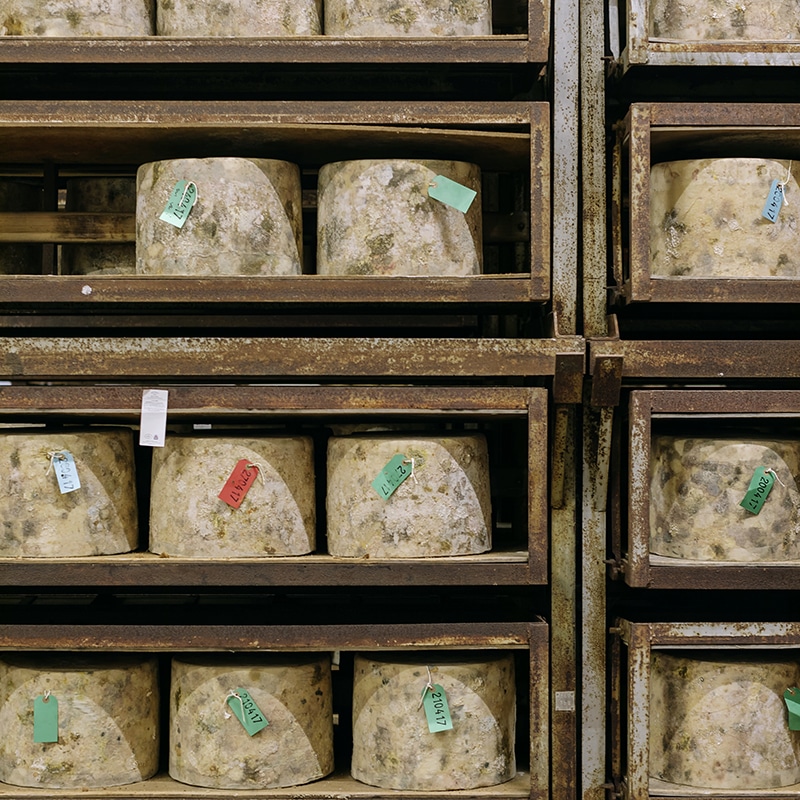
Do you think the microclimate you have here is particularly conducive to dairy farming?
Neal’s Yard Dairy described our cheese as “luscious” – it’s a good word for it. We do have this incredibly lush pasture. Our grass grows by itself, and it grows beautifully – incredibly. Among those farmers who measure their grass, it’s famous. We’re situated in a rich, alluvial valley next to the River Creedy – I always wonder if it’s a coincidence that it rhymes with greedy – and some of the swathes have been here since my dad’s time. I’m really pleased about that, because underneath perennial pasture you develop more organic matter, and those deep-rooted plants reach down into the soil and bring up nutrients.
You were at the forefront of a move away from intensive farming methods. What prompted that?
I’ve been on a journey. When I first came into farming, we had these thoroughbred animals that produced lots of milk. But it wasn’t right for our cheese. We thought, what’s missing? Grazing. But our pedigree cows didn’t really like grazing outside, so we crossed them with fresian, Swedish red, montbeliard and a teeny bit of jersey.
The farming method we use now is called extended grazing, which means the cows do all the work: they make their own beds, get their own feed, spread their own manure. It means when we work with the cows, we’re working with the animals, not with a machine. I don’t want to knock other systems, but for us, when we were producing higher yields and the cows weren’t doing as much grazing, the cheese didn’t taste how I wanted it. But it does mean the cows produce a lot less milk. There’s an argument that you should be producing as much milk from each cow as possible, from a carbon footprint perspective, because cows produce methane. But on the other hand, our cows are living longer so a lower percentage of their time is spent rearing and a higher percentage producing milk for the dairy. A grass-fed cow also produces less methane.
After years of crossbreeding and testing, do you feel like you’ve perfected the recipe?
Never! I’ve got this picture in my mind of the flavour I’m after, and I’m forever pursuing it. There’s so much to learn – chemistry, biology, physics. Milk is such a complex thing and it can go down thousands of different pathways, depending on countless factors. You couldn’t possibly know everything there is to know about cheesemaking. The complexity of the soil, breeding, the starters, what’s happening within the cheese when you make it and what’s happening on its rind. It’s glorious. That’s what’s so inspiring – you’re sitting on top of this incredibly complex, beautiful machine that you couldn’t ever possibly fully understand. It blows my mind. Yes, we’re trying to produce milk with a particular flavour, but there’s so much involved in finding the best cheese that’s sitting within it. It’s why we are constantly taste testing – often hundreds of cheeses within a few hours. We taste them at three months, six months, 12 months, to work out how long we should age each one. When is it going to be at its best? It’s a bit like Michelangelo looking at a block of marble: there’s a statue in there, and we’ve got to find it.
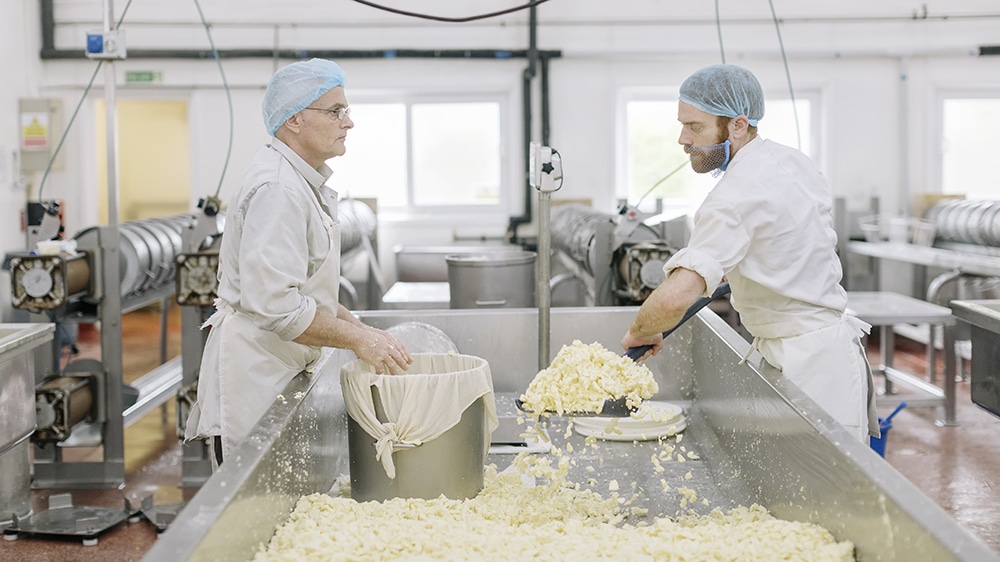
Explain what you mean by ‘heritage starters’.
A starter is a complex mix of microorganisms, with lots of bugs that operate in different ways, and each makes a stamp on the cheese. Our starters were collected from the best cheese dairies of the sixties and seventies, by somebody called John Lewis – nothing to do with Waitrose. Most industrial dairies use cultures that have a maximum of three strains of bugs and are much simpler in profile – for example, very sweet or very sharp – so the cheese they produce is the same every day. We use several cultures and because of that, there’s more variability. A winemaker has a vintage once a year; we have a vintage every day.
Our starters were actually almost discarded, at one point. They’d ended up in the hands of a French yeast-making company, who couldn’t make any money out of them, so they went to get rid of them. Fortunately, an amazing man, a microbiologist called Ray, stole them and brought them back to Somerset. To think – all those years of development. Those exquisite, complex flavours. You wouldn’t be able to replicate that. It’d be like destroying history or music or art – it’s no surprise they’re called cultures. They’re integral to the cheese. He rescued them.
Last year you set up the Cheese Academy. What was your intention?
One of the really fun things I get to do is go to America every year to judge cheese. They’re really interested in all the nerdy stuff, and so embarrassed by their dreadful sliced cheese – though they are now making some truly awesome cheeses over there, it’s a real challenge because the great bulk of people in America don’t know the first thing about cheese.
To address that, the American Cheese Society that runs this competition also set up something called the Certified Cheese Professional. Initially I thought, don’t be so Henry James. But then I saw all these young people getting so excited about cheese. Most people who find their way into cheesemongering get a job after school because that’s what’s on offer, and it just captivates them. But their knowledge doesn’t have any status. Getting a certification gave them honour and recognition. Not only that, it gave them confidence. I thought that was just amazing. I was unhappy with the certification we have here – which is only one level, for professionals, and you don’t even do any tasting – so I wanted to bring that to the UK.
The other thing is, while there are an awful lot of cheeses in this country and that’s really exciting, we need to create that pull of people wanting to buy it and sell it and serve it in their restaurants. The plank of Slow Food is, it’s got to be good, clean and fair – part of it being fair is being able to make a sensible living out of creating these amazing products. And you can’t do that if people don’t understand it. Why am I paying that much for cheese, when I can get it for a fiver a kilo in the supermarket? We need to be able to say, here’s why, this is the story, these are the flavours, this is what you’re getting for that money. The impact of the WSET Master of Wine programme in the seventies was crazy – now all sorts of wine has a place in the sun. We want to do that with cheese.
The dairy industry is known these days for being male dominated. Do you think that’s changing?
Certainly, in terms of cheddar-makers, I think I am the only woman leading a business. It wasn’t always that way. In all the old cheesemaking books, the cheesemaker is always a ‘she’. They were dairy maids. A lot of the traditional cheesemaking recipes fit in around child-rearing. Mechanisation really changed the field of dairy. Once it went outside the home and you had a machine to do things, suddenly men were interested! The irony is, mechanisation makes things easier for women: the standard weight you’d need to be able to carry 100 years ago was around 100 kilos, which is seriously heavy. Even when I started working it was about 50 kilos. Now nobody lifts anything. We’re not limited by the fact that women, in general, are a little less physically strong than men. While there are lots more women coming into farming, there’s still the sense that it’s a masculine thing to do. But really, it’s about knowledge and being thoughtful with it – which absolutely isn’t more suited to either gender.
Q&A: Mary Quicke
Mary Quicke, owner of Quicke’s and a 14th-generation cheesemaker, on complex cultures, the importance of grazing, and why more women should be running dairies


“WHILE MALE CHEFS ENJOYED CELEBRITY, THE SETTINGS IN WHICH WOMEN COOKED WERE GIVEN LESS ATTENTION”
Interview: Ellie Costigan
There has long been a strong cultural association between women and food. And yet, when it comes to public status, there has also been a very clear gender imbalance. At the highest end of professional cooking, males have tended to be very much on top, with women largely confined to the domestic space – although that distinction is now finally breaking down.
While big male chefs, from Auguste Escoffier on, have enjoyed fame and celebrity, the settings in which women traditionally cooked – usually ones that garnered little or no pay – have been given much less public attention. Most of the writers who have addressed that domestic space – the preparation of food, the feeding of the family, the everyday labours associated with cooking – have also been women, and they too have often been overlooked.
Perhaps not surprisingly, this imbalance is clearly reflected in the content of Wikipedia – one of the modern world’s most important sources of information. In conjunction with the British Library and The Oxford Symposium on Food and Cookery, a group of us have been working on a project to improve the site’s coverage of women in food. We found there were some really surprising omissions.
One of our most striking discoveries was that the 18th century cookery writer Hannah Glasse, whose influence on British cuisine was enormous, had an entry of about four lines. Many amazing food writers, historians, scientists and cooks, past and present – the likes of Diana Henry, Judy Rodgers, Patience Gray, Eliza Smith – were either missing entirely or did not have the coverage you would expect.
Around three-quarters of Wikipedia editors are male, and this has perhaps compounded the gender bias, but the problem goes far beyond that – the site is a reflection of cultural and social attitudes that have led to women being less accounted for in almost every sphere. The beauty of Wikipedia, though, is that anyone can become an editor, so we have the power to put this right.
It is important to remember that Wikipedia is relatively new, and exists in a constant state of renewal and expansion. Our work is a reflection of some wider shifts: in recent years, there’s been increasing recognition of the importance of understanding food, and its connection to culture and history, so a lot of forgotten women are being rediscovered. A real audience has developed for all these brilliant female food writers and cooks, whose work is now being published, read and celebrated. While the gender division remains stark, I don’t feel bleak about it. The exciting thing about food is, there’s always more to uncover; it’s a rich seam, and one we will keep on mining.
Q&A: Mary Quicke
Mary Quicke, owner of Quicke’s and a 14th-generation cheesemaker, on complex cultures, the importance of grazing, and why more women should be running dairies


“I HAVE A BRAIN AND TWO HANDS, SO WHY CAN’T A WOMAN CARVE HAM JUST AS WELL AS A MAN?”
Interview: Viel Richardson / Images: Orlando Gili
Have you always wanted to be a jamón carver?
As far back as I can remember, my mother and father carved jamón legs at home, so seeing jamón being carved has always been part of my life. It seems very natural to me. I started to train here about three years ago and loved it from the beginning. In Spain, being a ‘cortadora de jamón’ is seen as a respected career. At every wedding, christening, celebration and festival event you will find someone carving jamón.
Is the sense of tradition important to you?
Yes. I am a proud Spaniard, and this is a very traditional Spanish craft. It makes me feel good to be doing something that connects so deeply with my cultural heritage. But this has traditionally been a job reserved for men, and there were definitely some men who did not approve when I said I wanted to become a cortadora de jamón. One even said: “Are you sure you’re a woman?” My answer to them is that I have a brain and two hands, so why can’t a woman carve ham just as well as a man? Luckily that is changing and there are more female carvers in Spain now. I believe anyone should be allowed to see if they have the skill and passion you need, not just men and not just Spanish people. The man who trained me is Colombian and a very gifted carver.
What is the main aim of the carver?
Achieving the perfect slice on a consistent basis in a way that gets the most out of each leg. Each jamón leg is different, so it is not a case of simply following a set plan. People think the jamón slices have to be as thin as possible, but that is not the case. Each slice needs to be about the depth of a credit card, around two fingers’ width wide and at most two inches long. This is the size that allows you to experience best the combination of flavours and textures.
Is a jamón leg complicated to carve?
Yes, you really need to understand the structure of each leg, where the different muscle groups are located and what their different properties are. The same leg can have four or five different flavours. The part of the leg called the ‘jarrete’ is close to the hoof and doesn’t have a lot of meat. This means as the salt penetrates the leg during the curing process it develops a more intense flavour than other parts. My favourite part of the leg is the ‘caña’. It’s by the tendon. The texture is not the best, but for me the flavour is amazing. Then we have the ‘maza’, the ‘punta’, the ‘babilla’ – all these areas have different textures and it is my job as a carver to present each one at its best.
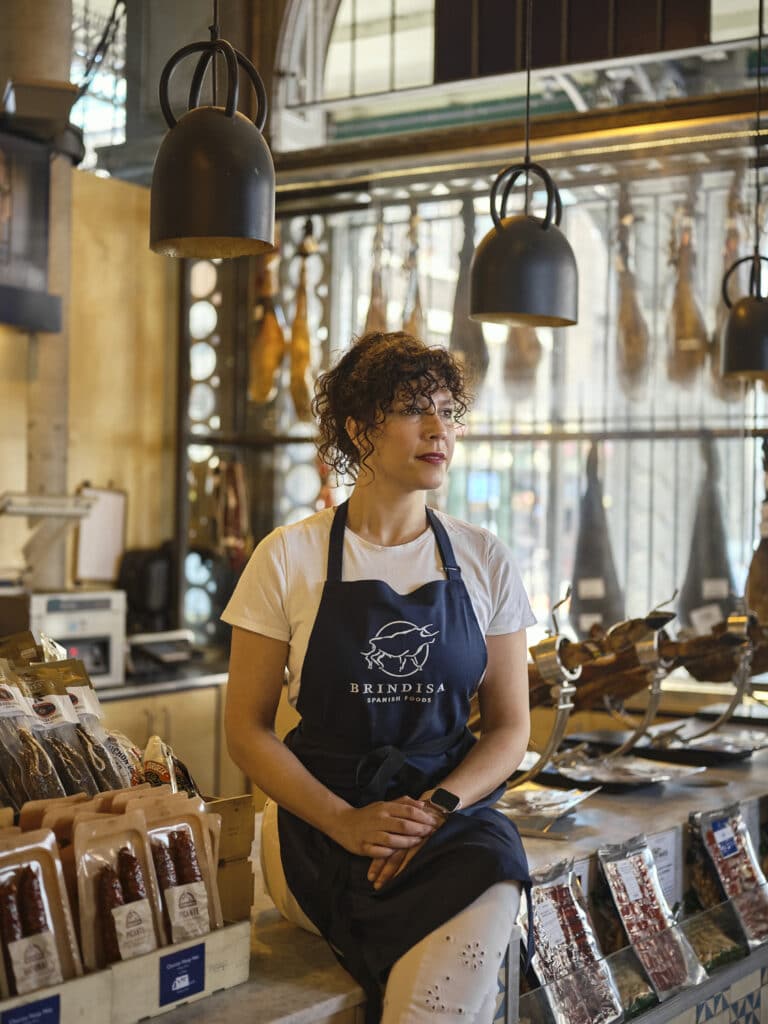
So there can be a variety of experiences for the customer?
Yes, there can. When I make a plate of ham at the start of each shift at Brindisa, or for events, I like to include slices from all the different areas of the leg so the people can experience the different flavours and textures. Of course, once you have started carving you cannot get to all areas at the same time, but I always get a minimum of two of the cuts in each serving and when I’m making up packets I try to get two or three cuts in each one.
You talk about the jamón with real reverence. Why is that?
Out of respect for the animal and the producers. A jamón leg takes time and care to make well and you need to respect the time and skill involved. You do this by doing your best to get as much product of each leg as possible while maintaining the quality of each slice. Nothing is wasted. Once we have taken off all the slices, we cut the rest of the meat into small cubes. These are full of flavour. You can eat them on their own with beer or wine. You can cook with them – making croquetas, for example – or you can add them to soups and stews.
Is it hard work?
It is physically demanding. I went to the doctor to ask about a lump I noticed on my hand and he said it was simply muscle that had built up through carving for several hours a day. Carving has actually changed the shape of my hand. I had no idea that I had a muscle there!
Do you need any special equipment?
Your most important tool is your knife. While there is no ‘official’ length, it has to be long and flexible. As a cortadora de jamón, you have to keep your knives extremely sharp. You also have to understand the different parts of the knife very well and while carving you will use different sections of the blade to carve different parts of the leg.
What is the most important aspect of the actual carving?
Keeping the blade parallel with the floor – this is critical for getting slices that are the same thickness all the way across. Wherever you are on the leg you have you make sure the knife is parallel, this can sometimes be tricky as the leg is a shape full of slopes and curves. Sometimes you have to cut away a piece of the leg to get the knife into the parallel position. You also have to be very aware of where the knife will go if it slips. Positioning your body, arms and hands is extremely important for safety. The knife is very sharp and a warm jamón leg can get a bit slippery.
What other qualities do you need?
To do this job well, I believe you also need a love of people. Yes, you can carve without it, but a cortadora de jamón is so often part of a celebration. Carving ham has some theatre about it. Engaging with the people you are carving for can make the occasion so much better. This is one of the things I love most about my job. You can see the joy it brings people and the interest it generates about your culture. People are so interested in the jamón: what breed it is, where it came from, how long it was aged for, the best way to enjoy it. For me, that connection is priceless.
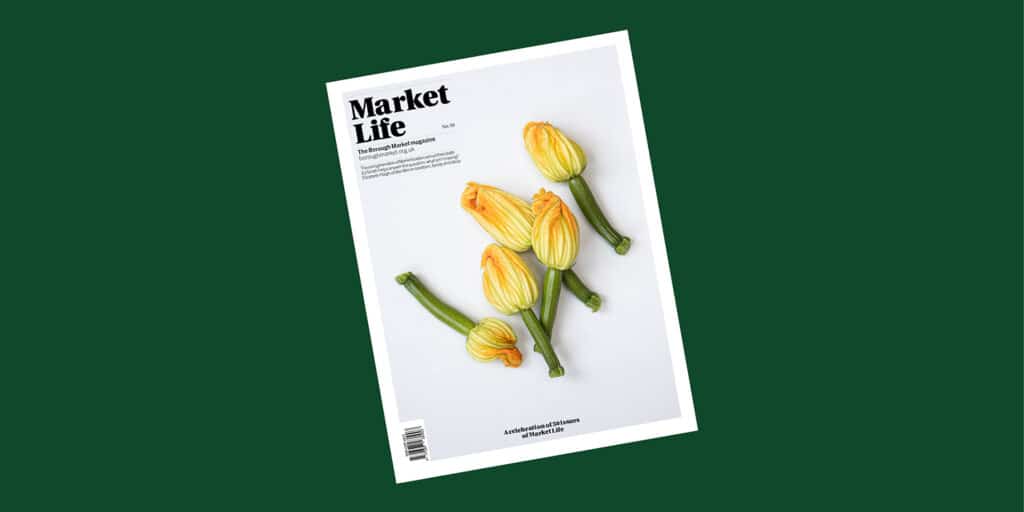
Market Life issue 50
The brand-new edition of Market Life includes an interview with Elizabeth Haigh of Mei Mei, recipes from Ed Smith and Kathy Slack, a guide to the art of ham carving, a piece on the new generation of Borough Market traders, and a celebration of our award-winning magazine’s half century.
